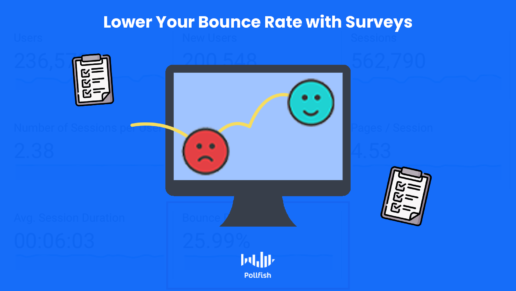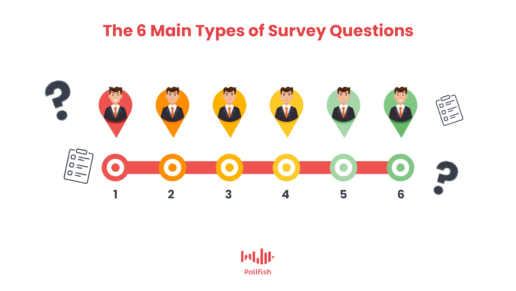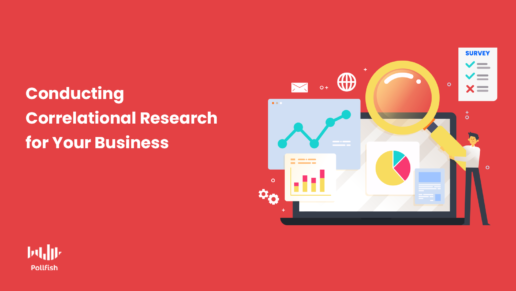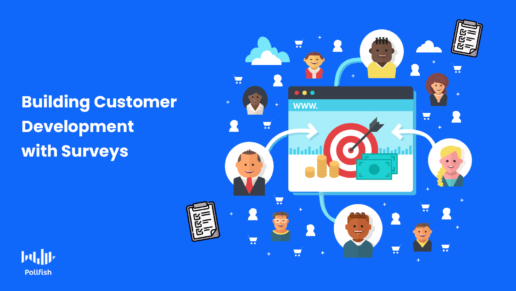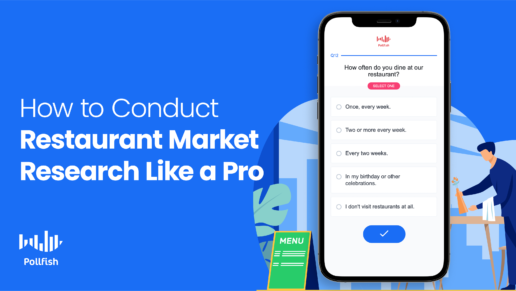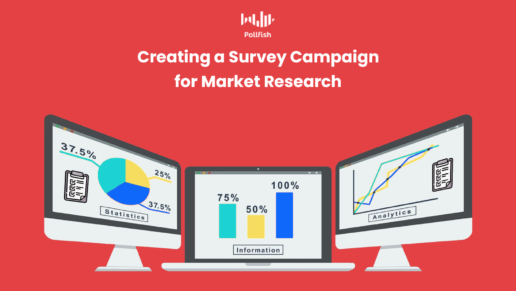How to Lower Bounce Rate with Surveys
How to Lower Bounce Rate with Surveys
How to lower bounce rate is a common contemplation among marketers, market researchers and business owners. As one of the main issues across digital marketing, the omnipresent bounce rate is a constant concern.
While the average bounce rate sits at a range between 26% and 70%, an acceptable bounce rate range is far lower. Many brands struggle with lowering their bounce rate to a more acceptable industry range.
There are various digital marketing methods to lower the bounce rate; some pertain to specific industries, while others are more generalized. A seldom but potent way to reduce your bounce rates is by way of conducting effective survey studies.
This article delves into how to lower bounce rate with surveys, so that you can improve your website and apps’ digital performance. This will allow you to elongate digital journeys, the time spent on your site and the interest surrounding your content.
Understanding the Bounce Rate
Before tackling how to lower bounce rate, you should have a concrete understanding of what it is. Bounce rate is a negative metric, that is, it measures the rate of an action that marketers ought to mitigate.
Specifically, bounce rate is the percentage of website (or app) visitors who leave a website after viewing only one page. There are certain circumstances that constitute leaving a page: this can occur via closing a tab, closing a browser, hitting the back button, typing in another domain in the URL on clicking an external link.
This metric is undesirable on several accounts: first off, it reduces web traffic. It also reduces the time spent on a website, as browsing several pages often results in a longer time spent on a website.
But most importantly, the bounce rate is an unfavorable metric as it shows that your landing pages do not appeal to your visitors. First impressions are critical — even in the digital space. As such, a high bounce rate points to disinterest, boredom or lack of satisfaction with a page.
Perhaps your visitors didn’t find the information they were looking for, or perhaps they were routed to a landing page via social media and upon entry, they lost interest. As such, high bounce rates occur when landing pages (or any web pages) fail to engage.
Market research, particularly surveys can help the lower bounce rate.
Bounce Rate Calculation
The calculation for this rate is rather simple.
Divide the total number of one-page visits by the total number of website visits. Then multiple the quotient (the result of the division) by 100 to get the percentage.
For example: A website receives 50 single-page visits and 180 total website visits.
50/180 = 0.2777777
0.2777777 x 100 = 27.777 or 27.78%
Bounce rate = 27.78%
Although you can calculate the bounce rate whenever you need to, a good rule of thumb is to pay particular attention to it whenever you release new content. For example, say you created a new resource page or added new marketing collateral to an existing page.
In these instances, you ought to compute the bounce rate to understand their performance. You can also compare it to the more stagnant pages on your website.
What Makes a Good and Bad Bounce Rate
As an undesirable metric, your bounce rate ought to be kept on the lower end of the spectrum. Lower bounce rates indicate higher levels of website engagement, which is critical for a number of business purposes: from branding to building customer loyalty.
To control your bounce rate, you first must understand which range indicates a “bad” bounce rate, that is, one that's too high, which constitutes a “good” or healthy bounce rate and which is considered average. The following breaks up the bounce rate into three categories based on reports of average bounce rates.
| Exceptional | Average / Mid-Range | Poor | |
| Ideal bounce rates | 26 - 40% | 41 - 55% | 70% |
| Most bounce rates (lowest-highest) | 1%- 26% | 45 - 49% | 90.2% |
When this rate reaches 70 percent and above, you ought to strategize on how to lower it, as it represents a deficiency in both content quality and UX. A rate this high is going to trickle down to fewer conversions.
However, a high bounce rate is only dismaying for content aside from blogs, news, events, and anything that requires a significant amount of reading — which introduces a new aspect of bounces.
Are All Bounces Terrible?
This aspect points to the fact that not all bounces are bad. As such, it is essential to factor in the context of your bounce rate. Take the following scenarios:
If you have a high bounce rate on a product page, in which the visitor leaves without purchasing or signing up for, say, a newsletter, then it is evidently a bad thing. If your visitor were to visit several such pages, thus, avoiding a bounce and lowering your bounce rate, it is good, even if they don’t convert.
This is because avoiding a bounce in this scenario shows that the visitor is interested in browsing your products. In the former scenario, a bounce on a product page shows that they are not interested in exploring your other products or site, and bouncing to a competitor site is a major possibility.
As such, bounces on product pages, landing pages and all others that require taking an action (converting) is a bad incidence.
However, some pages with high bounce rates do not necessarily connote a bad sign. Consider content-heavy pages, especially those with no CTA for further action, such as downloading a report or signing up for email notifications.
For example, let’s say a visitor is consuming a long blog post, report, article or news content. They may then bounce. Regardless, the page they consumed was engaging enough for them to read through the whole thing, thus contributing to longer times spent on the site.
Additionally, after reading the content, the visitor may have deemed your content authoritative, fostering future site visits. Or, it may have nurtured a lead further down the sales funnel. This is far more valuable than a site visitor who travels across various site pages (thus avoiding bounces) without reading or paying attention to the content and elements.
Bounce Rates Benchmarks Across Industries
Bounce rates fluctuate from brand to brand and the same oscillation applies to different industries. This occurs from a number of different factors such as:
- The nature of the industry
- The average UX efforts and updates made on digital platforms across industries
- The content-heavy nature of industries
- Type of website
Bounce Rate Benchmarks by Website Type and Page Type:
The following presents data on benchmarks based on the type of website and webpage from Custom Media Labs.
| Type | Bounce Rate |
| E-commerce and retail websites | 20% – 45% |
| B2B websites | 25% – 55% |
| Lead generation websites | 30% – 55% |
| Non-ecommerce content websites | 35% – 60% |
| Landing pages | 60% – 90% for |
| Blogs, news sites, dictionaries, portals | 65% – 90% |
Bounce Rate Benchmarks by Industry:
The following presents data on benchmarks across different industries in late 2020 by a report from SimilarWeb and others.
| Type | Bounce Rate |
| E-commerce and retail websites | 35.8% |
| Financial Services | 28.3% |
| Publishers (Radio, TV, press via apps) | 51.3% |
| Cosmetics | 55.86% |
| Grocery | 40.2% |
How to Lower Bounce Rate with Surveys
You may have pondered how to lower the bounce rate through a practical route. While you cannot extinguish the bounce rate, you can lessen it by improving your website in a number of ways. Most marketing websites will provide you with advice on lowering your bounce rate in the following two ways:
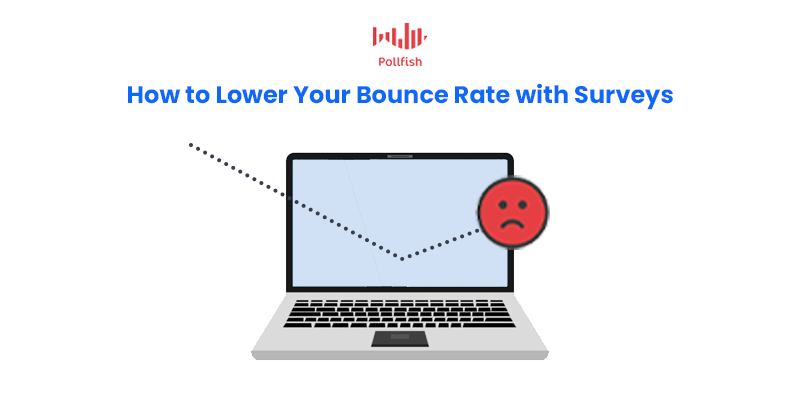
- Improving your user experience (UX)
- Fleshing out your content offerings
On the contrary and far less conventional, you ought to use surveys to reduce your bounce rate. Although slashing this rate may seem to be a feat, surveys help in that they find the disconnect between your visitors’ (and customers’) expectations from your webpages and what your webpages actually provide.
Businesses can use surveys to minimize the bounce rate for both B2C and B2B businesses. You can achieve the latter by implementing B2B surveys. If one of your biggest concerns around your bounce rate involves your content performance, you can deploy surveys for a content marketing strategy.
What to Ask in the Survey to Lower Bounce Rate
First off, you can ask respondents specifically what they look for in a particular landing page, product page, etc. In such a case, it is best to use multiple-selection multiple-choice questions, that is, questions that allow respondents to tick off more than just one answer.
This is especially useful if you deploy surveys across digital channels as part of an online survey platform. In this case, these surveys will be on websites (and apps) that are not yours, thus, you ought to ask for their specific needs.
You should also ask questions with visual elements (images, GIFs, etc) displaying your own digital elements. This way, respondents can see the makeup of your page and divulge their opinions of it. This question is especially viable when you use it to inquire about pages with the highest bounce rates.
Incorporating direct questions is another way to survey respondents to lower your bounce rate. For example, you can ask specifically what would make the respondents bounce. Piggybacking off of this concept, you ought to include questions that ask respondents to choose between a set of visuals, which represent pages or page elements.
They should choose the best and worst kinds from a set of images. You can also ask them to rate these pages/elements via a rating scale question or a Matrix question.
Setting Reasonable Expectations
The bounce rate is a metric you will often contend with. While bounces are not necessarily a grave issue on all site pages, certain pages, such as landing pages and product pages can do without high bounce rates.
Although known mainly as market research tools, surveys can provide the ultimate remedy on how to lower bounce rate. This is because surveys allow you to question your respondents on virtually anything, thus gaining you access into their psyche and needs from landing pages, etc.
When using survey research to crack down on your bounce rates, the key is finding the most apt online survey tool to house your surveys. Such as tool should make it easy to not merely set up and deploy your surveys, but make them hyper-targeted, so that only your target market and desired respondents can take part in it.
It should also automate quality checks to rein in survey bias and low-quality data. When you’re equipped with the correct online survey platform, you’re set to tackle lowering your bounce rates.
The 6 Main Types of Survey Questions to Power Multiple Applications
The 6 Main Types of Survey Questions to Power Multiple Applications
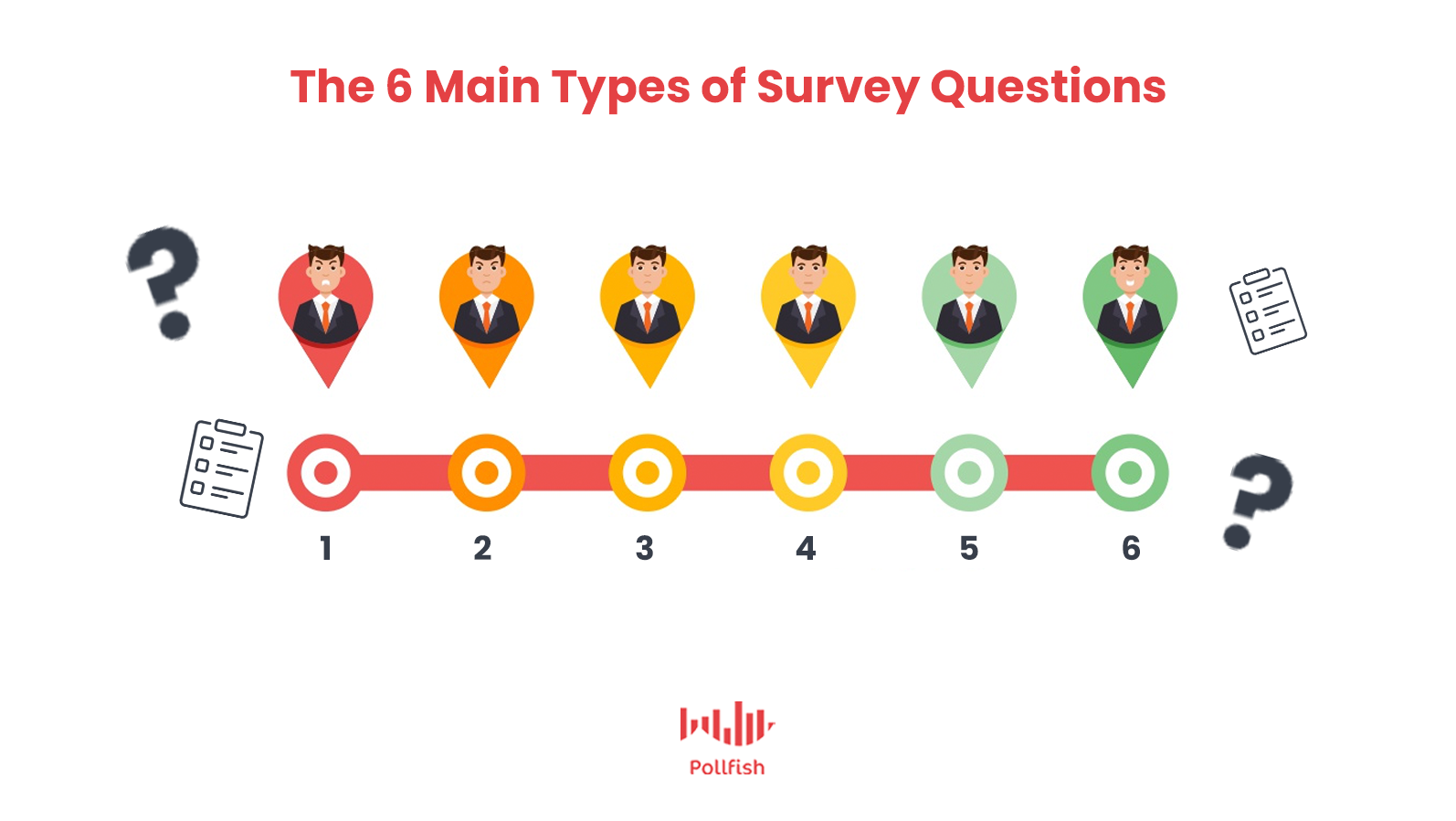 Survey questions are the core of any questionnaire and survey at large. It is the questions that drive the extraction of key data, insights and other information about your target market (for market research) or target population (for general research).
Survey questions are the core of any questionnaire and survey at large. It is the questions that drive the extraction of key data, insights and other information about your target market (for market research) or target population (for general research).
There are a wide variety of survey questions to implement into your survey campaign, whether it is for market research or other forms of research. There are also many ways to categorize questions.
This article expounds on the 7 main types of survey questions, namely market research questions, including examples and fitting applications, so that you can produce effective survey studies for your research campaign.
Close-Ended Questions
These questions are one of the most chief types of survey questions. They serve as the parent category in virtually every question type you’ll come upon in this guide and all others — except for open-ended questions, their antithesis.
Close-ended questions refer to any question that can be answered by selecting from a limited amount of answer options. These options can exist in various forms; these forms are the basis of the various offshoots, subtypes or child categories of close-ended questions (listed in the sections following the next).
Usually, these exist as multiple-choice questions, in which a respondent can select one answer, or choose several, i.e., all that apply to a situation.
Close-ended questions can draw simple, one-word answers, such as yes or no, or full sentence answers.
Additionally, these questions can be presented in a rating scale, such as “Are you satisfied with your experience with our company?" To which, the responses would exist in a scale: Very much so, mostly, yes, not sure, not really, no, not at all.
Close-ended questions are used to conduct quantitative research, in which data is collected to form statistics and discover patterns.
Although they give limited information, they are useful for several applications in the business world and virtually all others. They should be used when searching for trends and quantifiable behaviors and making generalizations.
Additionally, they provide quick insights into both general and specific topics, including important issues, such as that of trust:
“Do you find our website trustworthy to gather [niche] information?” This can be answered via a simple yes, no or not sure or as a rating scale question, e.g., from “not at all” to “very much so.”
Here are some of the most fitting surveys and applications for close-ended questions:
- Quantitative surveys
- Consumer surveys
- Cross-sectional surveys
- The NPS Survey and all other customer satisfaction surveys such as the CSAT and CES surveys
- Brand awareness surveys
- All customer experience (CX) surveys
- Business surveys
Examples of Close-Ended Questions:
- Did you find what you were looking for on our website?
- Which products do you look for/enjoy using the most? (Check all that apply).
- What times of the year do you usually plan a trip? [Multiple choice, multiple selection]
- Would you recommend our product/service?
- Which locations would you go to?
- What aspects of your life do you find most stressful?
- What kinds of services do you seek to help you through a difficult time?
Open-Ended Questions
The opposite of close-ended questions, these types of questions cannot be answered via a simple yes or no answer, nor can they be answered with single or multiple-selection multiple choice answers.
Rather, they allow the respondents full control over their responses. As such, open-ended answers can be short, consisting of a few words, to a sentence, to a paraph and beyond.
As their name suggests, the responses for these kinds of questions are limitless, save for the character count. These questions are used to extract in-depth responses to better probe into a topic. Additionally, open-ended questions can be used as follow-up questions to close-ended answers.
For example, if you asked the close-ended question: Which of the following brands do you feel is this best for your needs?
You can follow this up with an open-ended question that asks respondents to explain why they chose their answer.
Open-ended questions provide feedback in the customers’ own words, rather than with fill-in options that have been preselected. Open-ended questions form the core of qualitative research.
They help you draw more context around actions, opinions and explore the reasoning behind satisfaction and dissatisfaction with their customer experience (CX).
Here are some of the most fitting surveys and applications for open-ended questions:
- Qualitative surveys
- Retrospective surveys: they require these questions to express and compare feelings and opinions of the present with the past.
- Exploratory research: qualitative in nature, used in order to form hypotheses, define goals etc.
- Consumer surveys
- Employee feedback surveys, job satisfaction surveys
- Event evaluation surveys
- Prospective research
Examples of Open-Ended Questions:
- What was it like living in this neighborhood in New York?
- Please describe a time where you found our digital marketplace helped you make essential purchases.
- Why did you select [the previous question’s choice]?
- How do you typically deal with stressful situations?
- What would make you use our product/service again?
- Why do you choose this particular product over the others?
- Is there anything else we can do to improve your experience with our company?
Rating Scale Questions
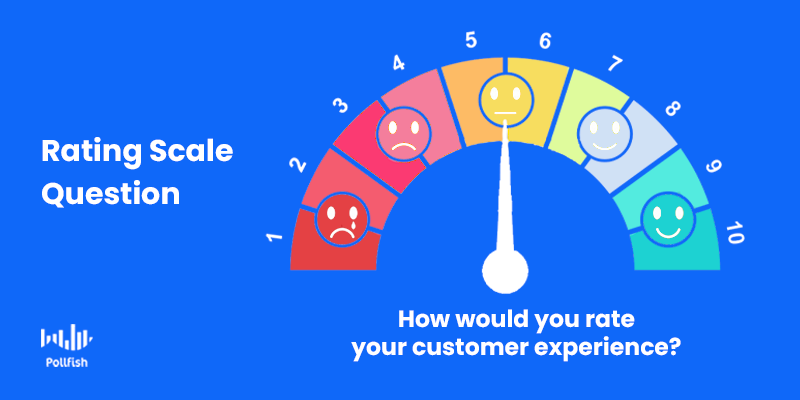
Also referred to as ordinal questions, these questions use a scale of answer options, as opposed to answers with words and sentences that denote separate objects and concerns.
As its name suggests, a rating scale question asks respondents to rate a sentence from a scale that uses numbers, emoticons, emojis or words. The words of the scale usually denote levels of either low to high intensity or go from negativity to positivity.
Respondents choose the number, word or emoji that best represents their answer.
Rating scale questions can be used for a number of applications. They are essential for questions that require far more nuance and precision than a yes or no answer. They are also ideal for a market researcher to understand their customers' exact feelings, attitudes and beliefs towards a number of business inquiries.
WIth rating scale questions, market researchers can further segment their target market by way of their opinions, which allows them to tinker their products, services or experiences more precisely.
Here are some of the most fitting surveys and applications for rating scale questions:
- NPS (Net Promoter Score) surveys
- CSAT (Customer Satisfaction Score) surveys
- CET (Customer Effort Score) surveys
- Likert Scale surveys
- Visual ratings surveys (ones that use hearts, stars, emojis or other visual ratings as scaled questions).
Examples of Rating Scale Questions:
- How likely are you to recommend this company to a colleague or friend, on a scale of 1-10? (NPS)
- Rate the following statement. Using the site navigation was extremely easy to do. (CES, a scale of extremely disagree to extremely agree).
- Overall, how satisfied are you with our company? (CSAT, a scale of extremely dissatisfied to extremely satisfied).
- The number of items in your online store overwhelms me. (Likert Scale, a scale of 7 options, strongly disagree to strongly agree).
- How would you rate your experience with our tech specialist? (Visual ratings scale, answers can use any emoji)
Matrix Questions
A Matrix question is a kind of close-ended question that asks respondents to provide an answer to one or more row questions using the same set of column answer choices. In this way, researchers do not have to create different answer types for each Matrix question, as each one can be answered in the same way.
It is similar to rating scale questions in that these questions ask respondents to rate or evaluate a number of services, occurrences of matters.
Like rating scale questions, each answer in a Matrix question carries a different amount of weight or intensity, from strong disagreements to strong agreements and other negative to positive responses.
The design of Matrix questions appears to be a chart, which makes it easy to identify and create.
Matrix questions are fundamental to use when your questions require nuance or you want to understand your customers’ precise sentiment in regard to your question.
While they can make it easy to interpret your customers’ answers, be wary when using them on mobile. Very long Matrices don’t fit mobile screens, which tend to be far greater in length than in width. They are not recommended for mobile.
Here are some of the most fitting surveys and applications for Matrix questions:
- Employee satisfaction surveys
- Descriptive research
- Customer loyalty surveys
- Evaluating advertisements and advertising campaigns
- Product satisfaction surveys
Examples of Matrix Questions:
- Rate the following: The customer support rep helped me resolve my issue. (Matrix from strongly agree to strongly disagree)
- How was your experience at our trade show? (Matrix from highly unenjoyable to highly enjoyable).
- How would you assess our webinar? (Matrix from very uninformative to very informative)
- How likely are you to make ongoing purchases from our online store? (Matrix from highly unlikely to highly likely).
- How many times will you make purchases from us in a year (Matrix from once to several times, such as more than five times).
Rank Order Questions
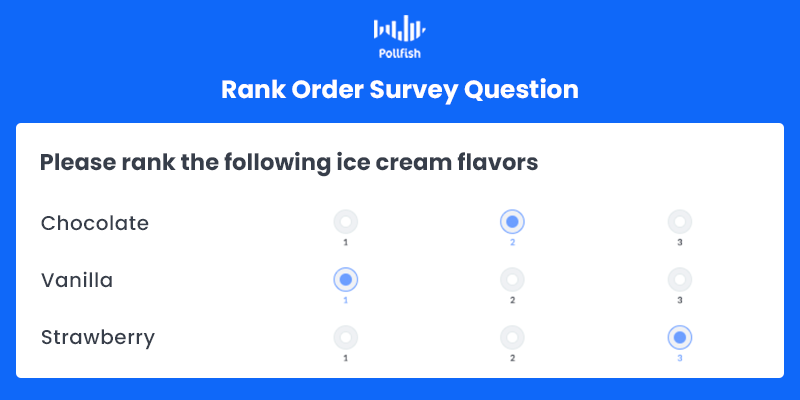
Also called Ranking questions, rank order questions ask respondents to compare items and rank them according to their liking. As such, respondents order the answer options by way of their preference.
It allows them to rearrange multiple choice answer options in the order of their choice, based on the opinions and attitudes they hold. Using rank order questions as opposed to other multiple-choice questions or rating scale questions is beneficial, as it lets researchers instantly understand their customers' preference of one item over another.
That is because the rankings are in each question, and unlike the Matrix scale, in which questions/ statements are on each row and answers are in each column, rank order questions feature the studied topics in each row and their ranking in each column. As such, a single question is set up in a Matrix-esque manner. As such, you the items and their ratings one after the other in one box.
This is also more convenient than other multiple-choice questions, in which respondents select multiple items without rating them or rating them but on an individual question basis.
Here are some of the most fitting surveys and applications for Rank Order questions:
- Product surveys
- All customer experience (CX) surveys
- Causal research and correlational research (in part but not in whole)
- Lowering the customer churn rate by understanding which products/ items need improvement
Examples of Rank Order Questions:
- Please rank the following pizza toppings. (Ranking depends on the number of items, ex if there are 4, rate them from 1-4).
- How would you rank the following seasonal fashion collections from worst to best?
- How was your experience with the following companies at the event? (Rate from I didn’t enjoy it to I highly enjoyed it).
- Rank the following accessories from our latest collection. (Ranking depends on the number of items).
Nominal Questions
Also called naming questions, or the categorical variable scale, nominal questions label variables into distinct categories. Unlike the various rating questions and rank order questions, nominal questions ask for answers with no quantitative value or weight of positivity, intensity, etc.
As such, these questions require no calculations of their answers, as each answer names a different category or type that has no quantitative relation to the other answer options. When numbers are assigned to nominal question answers, it is only for labeling or division.
The answers to nominal questions have no order; instead, they are meant to carry significance for variable labels only.
These kinds of questions are apt for initial research, such as exploratory, when researchers are trying to gather all the different variables present in their issue or situation.
They are also perfect to use when inquiring into the specifics of something, whether it is an occurrence, a preference or specific products, rather than rate them against one another.
Here are some of the most fitting surveys and applications for Nominal questions:
- Exploratory research
- Descriptive research
- Product satisfaction survey questions
- Cohort studies
- Advertising market research
Examples of Nominal Questions:
- Which brand of laptops from our store do you prefer? (Answers: Apple, Microsoft, Dell, Acer, Samsung, Asos)
- Where do you live?
- Which vacation destination do you want to visit the most?
- Which of the following ads have you seen?
- Which of the following ads would make you want to buy from us the most?
Making Every Question Count
While the 6 questions described in this guide are crucial for your market research endeavors, there are far more question types you can use to power your survey research. While this may sound daunting, the larger variety of question types helps keep your research quality high and fresh, giving you more types of data analysis to choose from and interpret.
Some questions you may come upon fall under one or more of the question types in this article, while others may be more unique. The most important thing to keep in mind is to not overwhelm your respondents with surveys and survey questions.
Keep your questionnaires relatively short and send your surveys to a random sampling pool. This will ensure that your respondents are not the same exact people every time — yet they still make up your target market/population. You can achieve this effortlessly with a strong online survey platform.
What is Correlational Research and How to Conduct it for Business Success
What is Correlational Research and How Do You Conduct it for Business Success
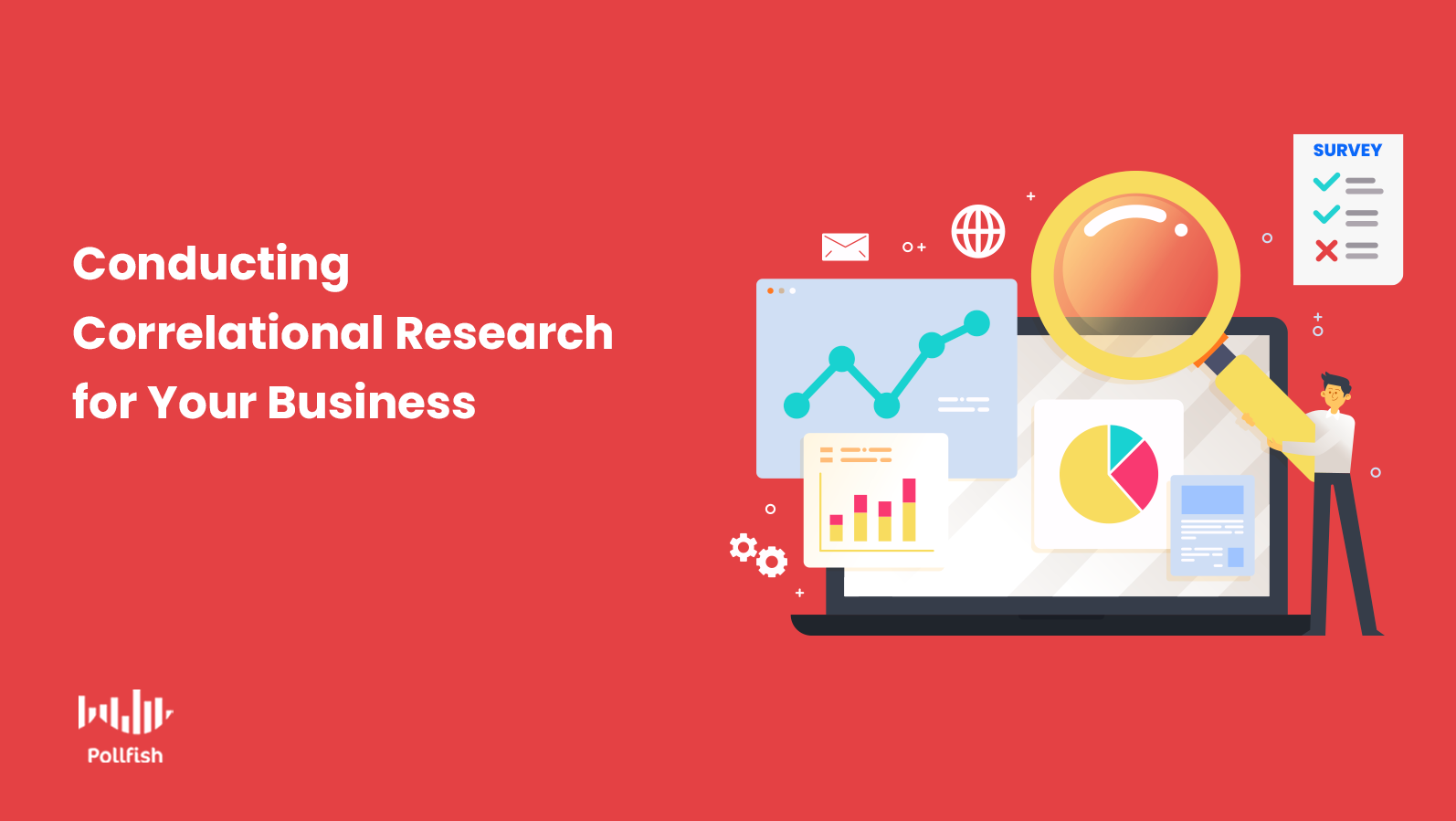
Correlational research is a critical form of research that researchers ought to deploy in the mid-late stages of the entire research process. It is especially necessary if it concerns a new topic.
Sequentially following descriptive research, which follows exploratory research, correlational research studies the relationship between two variables. This is important when attempting to make sense out of the variables discovered from exploratory and descriptive research.
Although correlation does not equal causation, understanding the correlation between two variables is crucial to see how similar such relationships may occur and how they behave within an existing occurrence, problem or phenomenon.
This article explains correlational research in-depth, including why it is important to conduct for business research, how to conduct it and more.
Defining Correlational Research
One of the chief forms of research, correlational research depicts and explains the relationship between two variables. This form of research is non-experimental, thus the researcher exerts little to no efforts to control or manipulate the variables.
The variables studied in this kind of research can be either quantitative or categorical.
Correlational research aims to find unknown or suspected relationships between variables, as this can point to similar behaviors or occurrences in other variables. If not, this kind of research is still powerful, as it paints a clearer picture of an issue or phenomenon that had been discovered in exploratory or descriptive research.
In correlational research, researchers measure the relationship between two variables, without controlling either one. The point of this kind of study is to discover:
- Positive correlation: Occurs when variables exhibit changes in the same way. Ex: As purchases increase, store traffic increases.
- Negative correlation: Describes variables that change in contrasting ways. Ex: Increase in employee burnout and a decrease in production.
- Zero correlation: When there is no relationship between the variables. Ex: Seeing employees in the office does not increase signed contracts with B2B partners.
The Key Aspects of Correlational Research
This form of research has several defining characteristics that researchers ought to consider. These aspects help identify this form of research, helping them use it for the future or to contrast it with causal or experimental research.
The following enumerates the key features of this research:
- As nonexperimental research, researchers do not need to manipulate variables to either agree or disagree with a hypothesis.
- It involves measuring and observing the relationship between the variables, with no external conditioning or alterations of any kind.
- It incorporates retrospective elements, as it looks back at past events and data of the variables, as a means to find and calculate historical patterns between them.
- It is conducted when there is some prior knowledge present from either exploratory or descriptive research so that at least one of the factors will relate to the predicted outcome.
- Although it may show a certain kind of correlation between variables, e.g. a positive one, it may not remain as such, as it can change in the future.
- Variables can be observed in a closed environment or via field research, i.e., a public space.
- It is used when the variables are too complex to be studied via the experimental method and controlled manipulation.
- It simultaneously measures variables and their relationships in realistic settings.
- It is executed when a relationship is suspected to be causal, but the researcher can’t manipulate the independent variable due to difficulty, impossibility or legal constraints.
- It is applied when one or a set of objectives requires gathering some degree of prediction.
Why Your Business Needs Correlational Research
Businesses benefit from conducting correlational research in a number of ways. Firstly, this research zeros in on previously murky or uncovered aspects from the entire research process, that of relationships between variables.
This research can confirm or refute these relationships, the hypothesis of their existence, along with the hypothesis of how they relate to the subject matter at large.
Secondly, when a business forms a clear understanding of the relationships between certain variables — whether they are good, bad or nonexistent, it is effectively equipped with the knowledge on how to move forward. For example, a correlational study may require further correlational research, causal research or experimental research.
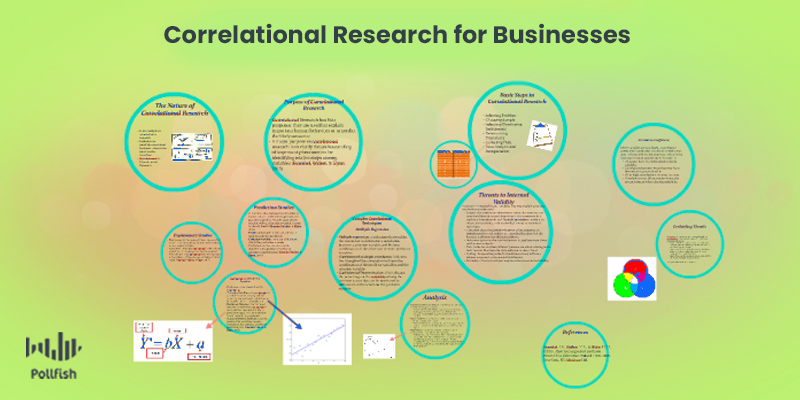
Or, it may require fewer studies while presenting actionable insights on how to proceed with the studied variables and their environments.
Moreover, it helps researchers understand their studied variables in relation to the past, as it compares present behaviors and other attributes of the variables with retrospective ones. Piggybacking off of this concept, correlational research also helps businesses form predictions.
These predictions pertain to other similar variables, or the same variables and can have a bearing on the near and later futures. Correlational predictions are particularly useful for detecting patterns.
Example of Correlational Research for Business
While there are many different verticals in the sciences and scientific offshoots (ex: psychology, medicine) that appear to require this research, it may not often be so clear as to how it can help businesses.
However, as expounded on above, correlational research is crucial for business and market research. Here is an example of how a business used correlational research in their overall research campaign:
A business noticed the reduction of sales when conducting exploratory research. They noticed that in correlational research, there were particular items that were especially plunging in sales.
Thus, they performed correlational research and discovered that there are two variables that may have a correlation: the rise in kitchen appliances and the decrease in sales of those appliances.
Accordingly, the business deployed surveys to their target market and loyal customers to understand whether in fact, there was a negative correlation present. The surveys proved that this was indeed the case. With this knowledge in tow, the business offered a discount on the appliances, also having considered lowering the prices after some time.
Correlational Research Survey Examples
- The qualitative survey
- Helps understand variables in greater depth.
- Can explain variable behaviors in relation to their environment/context.
- The retrospective survey
- Delves into past events, occurrences and attitudes in regards to the variables.
- Shows whether the variables changed and how so.
- The prospective survey
- Can find associations between variables over a period of time.
- Useful for studying variables to form predictions and understand outcomes.
- The customer loyalty survey
- Great for comparing loyal customers against those who don’t buy from you but are in your target market.
- Measures the variable of continuous purchases.
- The employee satisfaction survey
- Measures relationships between employee satisfaction and workplace or company policy occurrences.
- Helps compare happy and dissatisfied employees.
How Correlational Research Differs from Causal, Exploratory and Experimental Research
Correlational research differs significantly from the other main types of research methods such as exploratory, descriptive and experimental research.
However, causal research is often conflated with causal research. While both kinds of research concern studying the relationships between variables and are conducted in the mid-late stages of research, they study very different aspects. As such, they follow different approaches and measure different things.
Whereas correlational research simply aims to understand how two variables relate to one another, causal research attempts to find a cause and effect relationship between two variables. This research type is more involved in making comparisons.
Exploratory research stands in complete contrast with correlational research, as it provides the very basis of a research problem and forms a hypothesis for later research, without involving variables.
Descriptive research delves into describing something already established, discovered or suspected in exploratory research. Therefore, it is composed after exploratory research in the overall process. It is still an early part of the entire research process.
Unlike correlational research, it attempts to describe what exploratory research had already established in greater detail, with new aspects emerging. It is not concerned with examining variables.
Experimental research contrasts with correlational research, in that it involves manipulating and controlling variables, whereas correlational research exerts absolutely no control or alterations to the studied variables.
As its name suggests, experimental research forms experiments on the variables as a means to discover cause-and-effect relationships. Using a scientific research design, this research involves a controlled environment, one in which the variables can be measured, calculated and then compared.
The Advantages and Disadvantages of Correlational Research
Correlational research offers several benefits for researchers and businesses. However, as with all other research methods, there are a few setbacks to this type of research.
The Advantages
- Allows researchers to determine the statistical relationship between two variables.
- An inexpensive and effective (not time-consuming) research method.
- Grants the research to understand a variable unaltered, existing in its natural state to fully understand it.
- Variables in their natural state are more applicable to everyday situations.
- Although it can’t prove causation, a large amount of collected and analyzed correlational data can support a causal hypothesis.
- Enables researchers to understand the duration and strength of the relationship.
- Using the correlation coefficient to measure a relationship’s strength (ranging from 1.00 to -1.00), the results are easy to classify.
- Provides the most ideal transition to conducting causal or experimental research.
- Provides insight into the way variables operate and exist with each other that other methods cannot find.
- Can occur through quick research such as via surveys or observations.
The Disadvantages
- It is limited, as it can only glean the statistical information from no more than two variables.
- Does not take cause and effect relationships into account, as it doesn’t find which of the 2 variables creates the statistical pattern.
- Does not show which variable wields the most influence.
- Cannot be fully depended on for further research, as it employs past statistical patterns to determine the relationship.
How to Conduct Correlational Research
A comparatively simple and quick way to conduct research, correlational research can be conducted using field research, i.e., via natural observations, through surveys and via secondary research. Here is how to execute this research using all of these techniques.
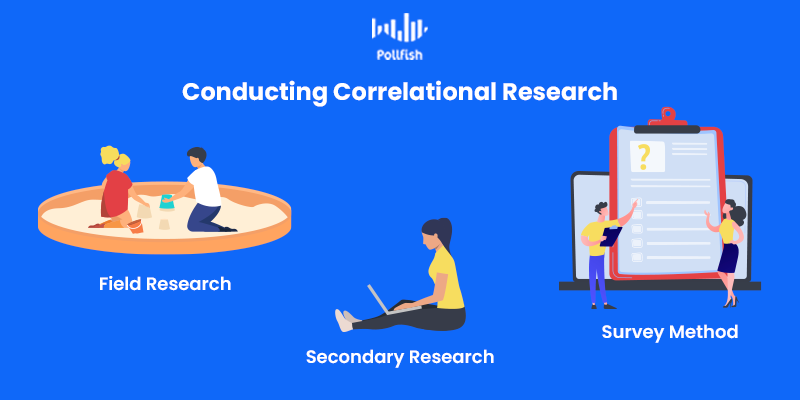
- Surveys: Allow researchers to get quick and easy to garner feedback (via an online survey platform).
- Ask questions about the variables. Use both open-ended and close-ended questions. The former is better for understanding the variables at a greater depth.
- Then, statistically analyze the answers.
- Field Research: Observe the variables in their natural environment.
- Study customers and passersby in physical shops, use a session replay tool in online shops.
- Record behaviors as they relate to the variables.
- Conduct secondary research: Find all the applicable literature and sources made available.
- These depend on your vertical and subject of study.
- Put them together and compare them to your own findings.
Mastering Correlational Research
Correlational research, although in the mid-stages of research, forms the very onset of relationship research into variables. Like descriptive research, correlational research describes variables, going a step further, as it tracks how one relates with the other.
It is essential to conduct this research to understand the kinds of relationships that exist between two variables before performing any testing on them, whether it’s for comparisons in causal research, or for experimentation in experimental research.
A strong online survey tool makes this possible and practical to carry out. As aforementioned, there are various surveys relevant to use for correlational research. An adept online survey provider will make it feasible to implement all forms in your research, along with sending them to their intended sampling pool.
Diving Into the Event Evaluation Survey to Excel in Event Marketing
Diving Into the Event Evaluation Survey to Excel in Event Marketing
Various businesses can benefit from an event evaluation survey, as many businesses implement event marketing.
Even if your business does not have an event marketing department or sub-department, you may still put together an event — whether it is for a cultural event with your team, a store’s grand opening, or a first foray into a marketing event.
This article delves into the event evaluation survey, its importance, how to create one, among other key aspects you ought to consider.
Defining the Event Evaluation Survey
Before delving into the definition of an event evaluation survey, it is critical to understand its premise: event evaluation. This simply refers to the actions performed to assess an event.
While there are many components of an event that require using tools other than a survey — such as attendee count, RSVPs, invitations sent, total expenditures, revenue or expected revenue from the event — the success of an event largely depends on its reception.
A survey can gauge this, which is specifically what an event evaluation survey does. As such, an event evaluation survey is a kind of survey designed to examine the opinions and attitudes of an event, usually deployed post-event to allow businesses and market researchers to measure its success.
Aside from discovering its success, this survey can unearth how attendees truly felt about it, which includes its shortfalls and inconveniences. In turn, this allows brands to create better events, including the kind that foster prospects into leads and nourish leads further down the sales funnel.
Why Your Business Needs an Event Evaluation Survey

The event evaluation survey is not merely a tool used to extract the feelings of attendees after an event. Rather, it is a key aid to event strategy, the comprehensive practice of planning and executing an event.
Event strategy covers everything from concept development to planning the event, to working out the logistics and all else that involves setting it into motion. A well-produced event evaluation survey can derive insights into all of these event-centered nuances.
These insights will edify you on how to build productive future events, whether they are big or small and whether you’re the host or a guest. Additionally, an event evaluation survey can inquire attendees on matters not directly tied to an event itself — rather you can use it to ask about other key issues concerning your business that were in some way involved in the event.
For example, if you’ve attended a tradeshow, you can ask questions related to new business offerings that were highlighted somewhere in the event, such as at a booth, or brought up by a sales representative via word of mouth.
Or, you can ask questions about your customer service in relation to the event to leads and customers who have had some experience with your company.
Combining both of these facets — questions about the event itself and questions secondary to it regarding your business, form a valuable survey.
How to Create an Event Evaluation Survey
In order to create a fruitful event survey campaign, you’ll need to first evaluate the event yourself. Before coming up with the questionnaire, consider the kinds of high-level inquiries you have or will have after it concludes.
To understand these, consider the following:
- Who is expected to arrive at the event? Leads only or other segments of your target market? Or, perhaps customers in other niches similar to yours.
- Will people want to take your survey? This may depend on how long the event was and how involved were the participants.
- Do you need answers to better build future events or to push people further down the sales funnel? (Do you need attendees to be further nurtured, and if so, by how much?)
- Are you looking to see how much your attendees learned about your product or offering after the event? This can help inform your content marketing strategy and other marketing efforts.
- Do you need general information or more information for future events? This involves considering how events are run, especially if you are a visitor at an event and are considering creating your own company event.
Once you’ve narrowed down your needs to one of the above considerations (or more), you can start creating a theme around the survey on which your questions will be based.
Before composing the questions themselves, consider the types of survey questions you’ll need to use to power this kind of survey. After mulling over the kinds of available questions there are for creating this survey, you can start thinking up your questions in relation to the above topics.
Remember to keep your survey short, with a maximum of 7 questions, although 4-5 can suffice.
While there are numerous kinds of questions you can apply in your surveys, only a few are best suited towards an event evaluation survey.
Types of Questions to Use in an Event Evaluation Survey
The following presents the kinds of questions to implement into your event survey.
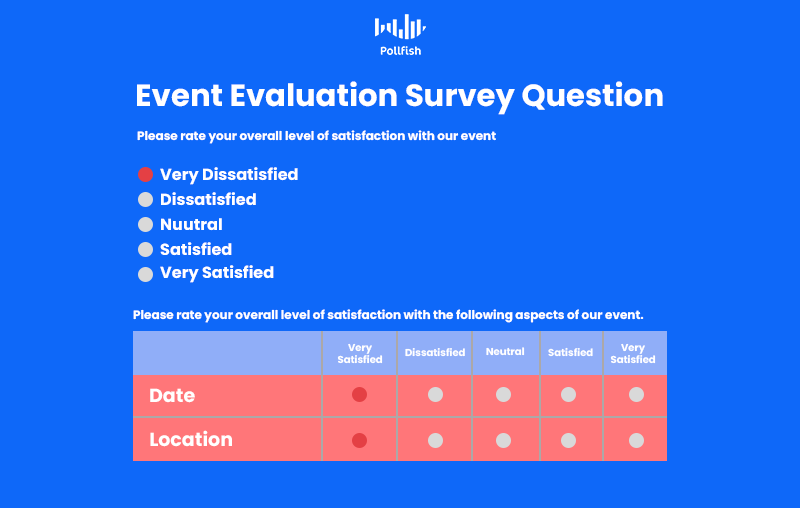
- Yes or No (Dichotomous)
- Some questions warrant a simple yes or no answer.
- These questions can follow up with an open-ended question so that your respondents expand on their answer.
- This is especially important if they answered “no.”
- Rating- Scale Questions:
- These questions offer scaled answers to show the intensity behind a feeling, thought or agreement with a statement. These include questions that constitute the concept of entire surveys, such as:
- NPS (Net Promoter Score) surveys
- CSAT (Customer Satisfaction Score) surveys
- CET (Customer Effort Score) surveys
- Likert Scale questions
- Visual ratings (ones that use hearts, stars, emojis or other visual ratings as scaled questions).
- These questions offer scaled answers to show the intensity behind a feeling, thought or agreement with a statement. These include questions that constitute the concept of entire surveys, such as:
- Multiple Choice:
- Can be scaled or nominal (answers with different names and categories and no scaled or numeric relationship)
- Can involve rated questions, aka, semantic differential questions
- Open-Ended Questions:
- These involve an open field for respondents to explain their multiple-choice or single-choice questions in greater detail and in their own words.
- Provide qualitative data.
Event Evaluation Questions Examples
Now that you understand how the questions in these surveys are classified, you can move on to composing the questions themselves. Make sure you use a variety of the above question types. This kind of diversity helps keep respondents more engaged with your survey.
Additionally, it gives you more varied means of uncovering key information on how your event has been received, how it can improve and how it’s excelling.
Here are some key question examples:
- On a scale of 1-7, how satisfied are you with this event?
- Type: Likert scale question
- Use: A general question such as this one grants you an understanding of the overall feel that attendees have of your event.
- This question gives you an idea of whether your event visitors were satisfied or not with your event. It also guides your survey into more specific questions.
- Was there anything in this event that you did not like?
- Type: Multiple choice question, can be followed by an open-ended question
- Use: This question is key to revealing how your event fell short and where it can stand to gain improvement.
- Use a multiple choice question if you expect certain categories to not perform their best, if you don’t have any in mind, present this as an open-ended question.
- How satisfied were you at this [specific point or interaction] in the event?
- Type: CSAT (Customer Satisfaction Score) question
- Use: This question brings a key moment in the event to light. Perhaps there was one particular speech, or moment in a speech you need specific feedback on. Or perhaps, there was an activity planned (which included a high expenditure) you need feedback on the most.
- What did you like the most about the event?
- Type: Multiple choice question, multiple selection question
- Use: This kind of question should include more than one answer, as such allow respondents to tick off several boxes. This will help you understand what you’re doing well in your event, to possibly repeat in the future.
- Add a follow-up open-ended question, or an “other” option with an open field.
- Do you have any suggestions for future events, including the time and date, the venue, speakers, sponsors, etc.?
- Type: Open-ended question
- Use: A very specific question, it also asks for suggestions, meaning things that previous questions shouldn’t have covered. As such, keep this as one of the final questions, if not the final one.
- This gets you to the bottom of exactly what the respondents are looking for in future events. Following their wishes will prompt greater attendance.
The Pros and Cons of an Event Evaluation Survey
Using this kind of survey has a wide swath of benefits, some of which you may have already grasped. However, there are even more advantages to using this survey. But with the good comes some undesirable qualities. The following lists both the benefits and setbacks of using an event survey.
The Pros
- Gaining valuable, specific insights about an event both in whole and in specific parts of it.
- Uses questions that give you insight into customer satisfaction and customer desires, allowing you to understand how to better cater to your target market in general.
- Provides insight on what can be improved and what is desired.
- Grants you insight into what to spend on in future events, helping you budget correctly.
- Show you how you compare with other business guests at an event (such as an expo or trade show) depending on the questions you use.
- Shows you what to avoid and thus what not to spend funds on in future events.
- Allows you to compare customer/attendee behavior with feedback, i.e., their true thoughts.
- Educates you on how to organize a future event and understand how to calculate its scale more fittingly.
The Cons
- Many event-goers may not want to take a survey.
- If a survey is administered during an event, attendees may rush through it, thus tainting the quality of data.
- Some responses may further explanation or questions, which not every survey provides.
- May not get useful answers from neutral respondents i.e., those who do not feel any particular way about your event, which won’t show you how to improve or what to continue doing in the future.
Excelling in Event Marketing and Beyond
An event evaluation survey is a crucial tool for making sense of your events and understanding how they are received. Usually, it is associated with event marketing, the discipline of marketing that promotes a company via live events (or virtual events, as is the current case).
However, this kind of survey can help you excel on so many other fronts in your business. As such, you can use it to better understand your own company-wide events, such as kick-offs, monthly, weekly or annual meetings or post-work cultural events.
This is particularly valuable for HR-related manners, such as company culture and employee satisfaction at large. After all, when keeping a pulse on your company, you need to assure your employees are happy as well (and fully aware of the company’s direction and their own responsibilities).In this way, the utility of the event evaluation survey highly extends beyond measuring the success of events alone. The key to reaping the most out of such a survey is with the correct survey tool. A strong online survey platform can help avoid some of the cons that were aforementioned.
How Surveys Foster and Improve Customer Development
How Surveys Foster and Improve Customer Development
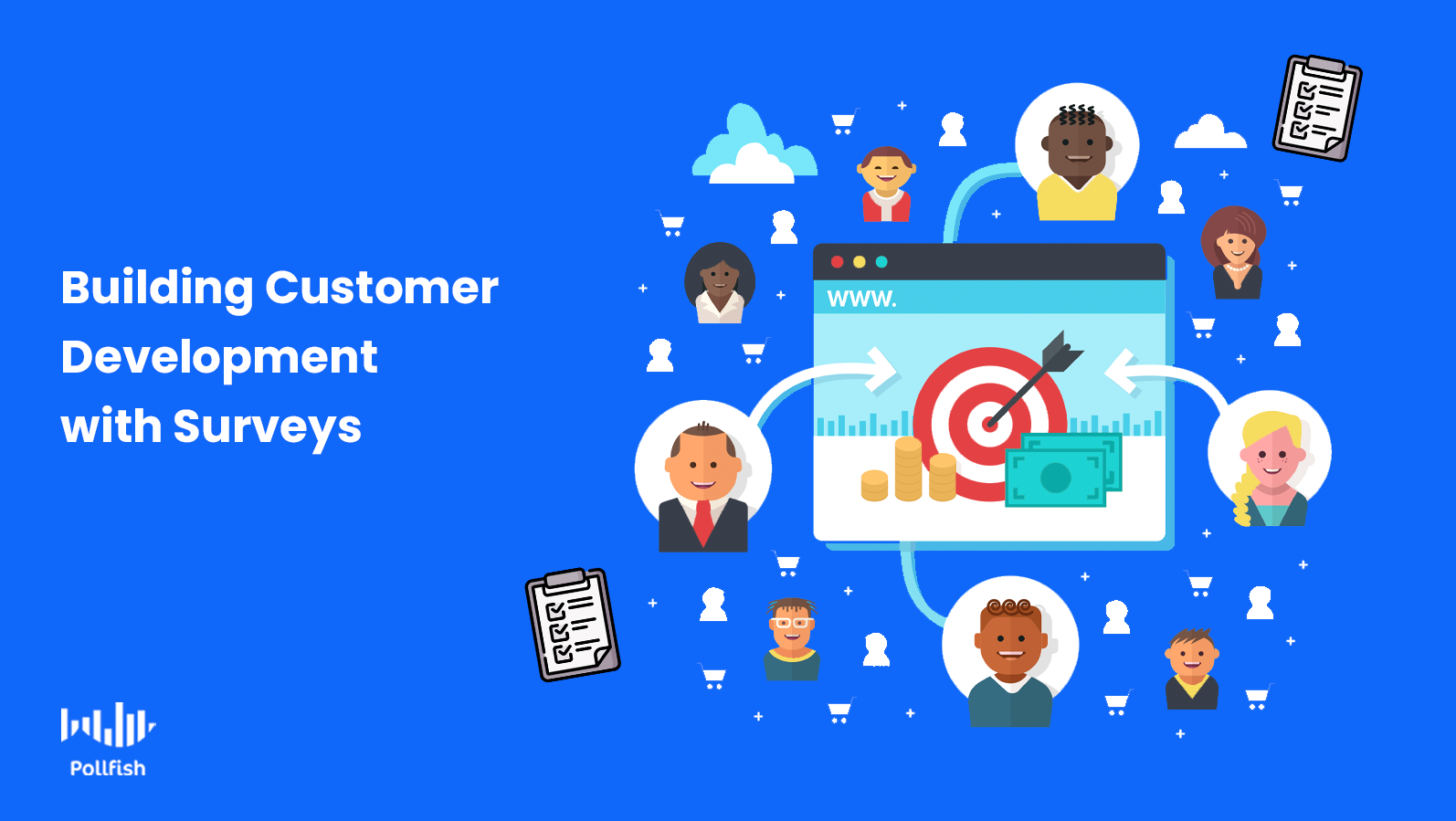
Customer development is a specialized method designed to satisfy your customers, a critical need for your business, especially in times of uncertainty.
Specifically aimed at startups, this framework was developed as a part of the Lean Startup methodology, a product development process bent on experimentation, repeated product releases and customer feedback, or VoC.
Customer development ensures that businesses understand market needs before launching a product, allowing them to foster and maintain product satisfaction. As such, all businesses, startups or not can benefit from understanding how to conduct this methodology.
Aside from providing key insights on the general market, surveys can help you attain product development so that you shorten the product development cycle and appease customers.
This article delves into the practice of customer development and expounds on how surveys can both foster and perfect the customer development process.
Defining Customer Development
Customer Development is a structure used to ascertain whether a product satisfies the need(s) of a target market. This framework is part of the lean startup concept, which dictates how startups must form and be managed, in order to bring a product to market more efficiently and grow at scale.
Conceived by entrepreneur Steve Blank, customer development is the mid-portion of the lean startup model, designed specifically to tackle the problem found within product development. As such, it requires to first fully evaluate the product opportunity and then prove that the solution proposed will, in fact, meet market demand and customer needs.
This framework was produced specifically for startups, as Blank observed that startups are not merely smaller versions of more established businesses. Instead, they require their own adapted approach.
As such, the customer development concept was conceived, running counter to traditional product development. Instead, it aims to test if a product will be viable for its target market via the lens of customer demand.
The 4 Steps of Customer Development
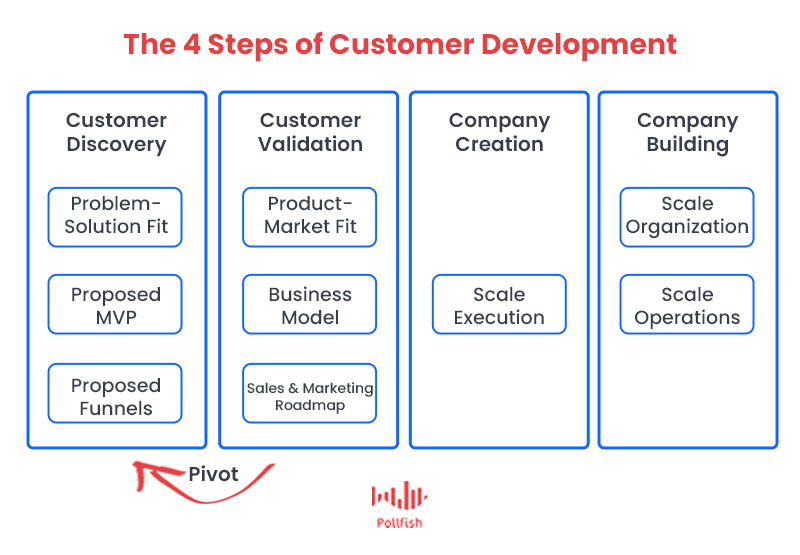
- Customer discovery: This is underpinned by understanding your customers and their needs, specifically the kinds that your product/service may be able to fulfill.
- Instead of starting with a hypothesis, customer discovery is set on finding how to make a proposed product/ service best serve customer needs.
- This involves putting together a business strategy and then testing two hypotheses:
- The problem hypothesis: your understanding of customer pain points
- The product hypothesis: your solution to these pain points
- Gain feedback on customer needs, pain points and attitudes on existing or similar products.
- Customer validation: You gain validation via selling your product, after your target market approves of it from Step 1.
- Form an iterative sales process, one bent on scaling. This involves selling to “earlyvangelists,” the customer segment that quickly understands the need for your product.
- Create a business model for the product, using the insights from Step 1. Include value propositions, product positioning and sales collateral.
- Company creation: Work on increasing your demand in this growth strategy stage.
- This stage typically already has an established demand for your product; as such, determine how to heighten the demand.
- It’s crucial to keep gathering customer feedback, conducting market research and using the knowledge you’ve gained to adapt your product.
- This is not an exploratory phase; rather it deals with maintaining your demand retaining customers.
- Company building: Continue supporting the growth of your business.
- This step includes defining the need for certain roles, developing more business departments and hiring more employees as a means of scaling.
- Not every startup will reach this stage, as it is a signifier of company success and a transition from a fledgling business to a full-fledged company.
- Achieving this stage may require redoing the customer validation or creation steps.
The Departments Involved in Customer Development
Although the product team is primarily involved, this is a cross-functional practice. Therefore, it involves a wide range of departments and sub-departments. This includes engineering, marketing, sales and product marketing.
When it comes to understanding the target market, reaching out to it and extracting its opinions, the most fitting teams are the marketing and product teams, as they are largely involved in appealing to the public. Their prowess hinges on talking to existing customers and gaining new ones, so they are the most suitable for outreach.
Additionally, many kinds of martech — software made particularly for marketing, are available to this team for gaining customer data. They can consolidate the data derived from martech, along with other forms of outreach when forming the basis for market needs.
Despite seldom involvement in customer interactions, founders, executives and C-level employees should also take part in this methodology. Their decisions often hold the most weight, and for good reason, as they have the experience and authority to make decisions that steer a business to success. As such, they should work in tandem with the other departments.
The members of higher-up teams must be open to findings and ideas that challenge their own beliefs and hypotheses, as market demand ultimately comes from the customers. Not all executives and founders will see eye to eye with customers, especially when certain target markets are more inclined to change their opinions.
They will have to cooperate with the other departments and leave their egos at the door in order to ensure successful approaches, accurate findings and data-based decisions,
Why Customer Development is Important for Business
This structure is crucial for businesses when it comes to bringing new products and services to market. While it is particular to startups with untested new products, businesses of other sizes and scopes can benefit from executing customer development.
This framework primarily allows businesses to validate the market demand — and to a significant extent — the success of a new product or business idea. It proves or disproves the viability of a new product, which is invaluable.
This is because investing in new solutions is often costly, time-consuming and laborious. It would be a colossal waste of time and money to invest in a product that evokes little to no market demand, especially from your target market, the customers most likely to buy from you.
Thus, customer development protects businesses from investing their resources into unvalidated or unproven products or product ideas.
In addition to this, this methodology helps prove that the product will, indeed, be of use to the customers. These insights help startups or even established companies discover which products are justified to produce and deploy, which require more customer opinions and which to completely disregard.
This process also helps weed out any opinion or intuition a business has, leaving emotions out of key decision-making steps, given that data takes the reigns.
Moreover, performing customer development produces a favorable fundraising outlook for a business. This is because it shows possible investors that the company has performed the necessary steps in validating a product launch. This is especially necessary for startups, which face a larger risk of failing and have less capital than an established business.
After all, investors will seek out stable products, those with a promising chance of profit, rather than products with no proven viability.
Finally, this methodology grants businesses the knowledge that allows them to make prioritizations. By understanding the needs of a target market, a business can produce only the most sought-after products and services, rather than venturing into every possible need its target market has.
How Surveys Help Customer Development
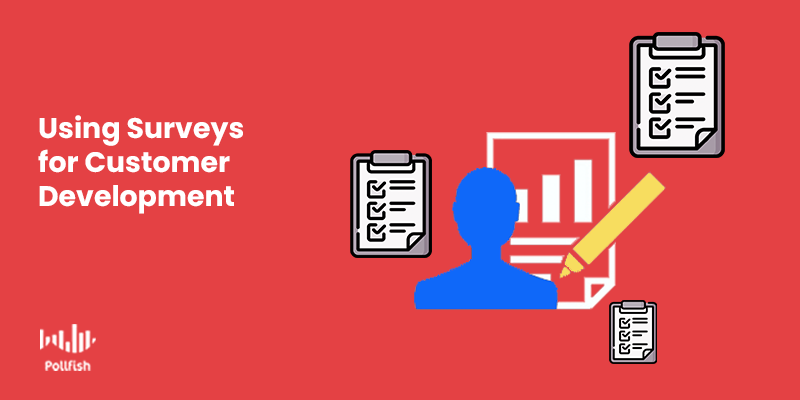
Surveys are necessary to use when taking part in the customer development process, as they not only bolster the process. Rather, they serve as the essential tools for gathering customer feedback, made possible through various kinds of consumer surveys.
They are essential in that customer development is founded on the basis of asking customers and potential customers, i.e., the target market, various questions on their needs, desires, pain points and opinions as they relate to your product or solution.
While it certainly is possible to use focus groups and conduct phone interviews, surveys present a far more efficient solution in gathering feedback. This is because they can be deployed to the masses and obtain responses in a relatively short amount of time (think several days as the maximum).
What’s more is that surveys ensure that you are only obtaining answers from those in your target market. They are granular, as you can target segments of your target market, as well as target respondents based on their responses to screening questions.
Surveys allow you to gain valuable insight through open-ended questions, which, in turn, allows you to derive key insights on how your product idea is viewed and gauge the need for it. As such, these insights are critical for Steps 1 and 2.
However, you can continue strengthening your market research in later steps as well, by applying surrey research, along with other primary research methods. Most importantly, surveys allow you to bypass using other primary sources, as you can ask virtually anything in your surveys to justify product development.
Scaling Your Startup & Business with Continuous Insights
Every startup needs to conduct customer development in order to assure a viable and efficient product launch. Even seasoned businesses can stand to implement this process, as it forgoes unvalidated opinions, the kinds that can set a business up for failure.
Instead, it concentrates on gathering customer information and key insights on market demand, which in turn can confirm speculations and justify new products. Much like its broader lean startup methodology, it grants businesses a formulaic approach to produce and deploy new products and solutions.
Given that surveys are a key component in the process, especially in regards to gaining actionable insights, an agile survey platform is a must. Any errors occurring in the survey process will taint the results, essentially making them biased, void and useless.
To avoid this major inconvenience and waste of time (something that surveys are supposed to save), a business must use an adept online survey tool, the kind that offers ease of question-building, targeting and deployment.
How to Conduct Restaurant Market Research Like A Pro
How to Conduct Restaurant Market Research Like A Pro
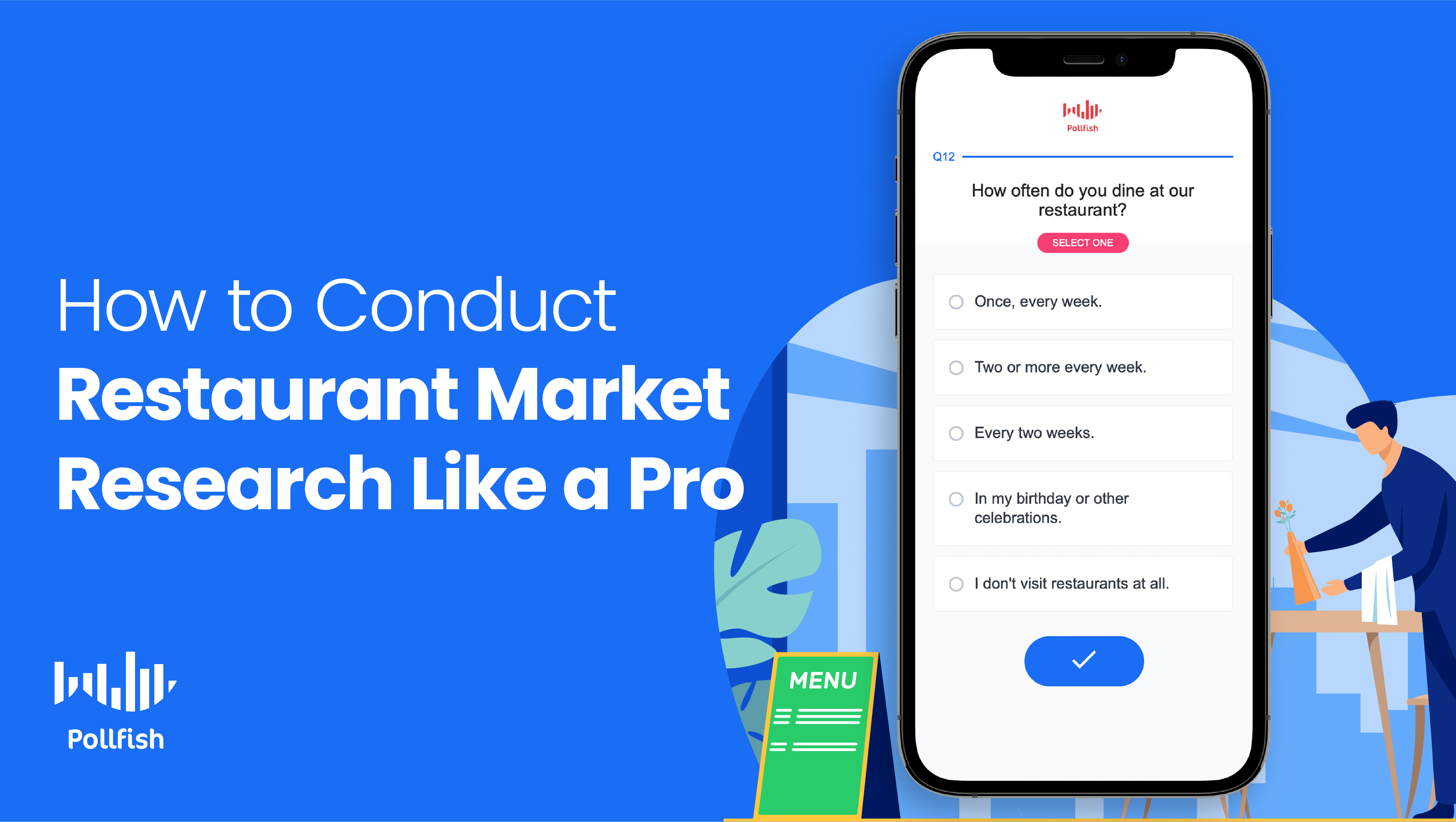
Restaurateurs, cafe owners, and eatery purveyors must conduct restaurant market research, as it is a highly competitive restaurant industry. Given that the industry is dominated by changing customer habits, businesses need to conduct thorough research to uncover potential opportunities.
As new restaurants open every day, the competition also increases. To stand out from this competition and ensure that prospective buyers know about their brand, restaurants must find strategies that enhance customer experience and content marketing strategy and advertising.
That usually involves an in-depth analysis of their customer preferences and an understanding of their competitors, neither of which is possible without restaurant market research. This article explains how restaurant owners can research their target market to ensure continued success, along with what market research means for the restaurants and the benefits of adopting these strategies.
The Growing Demand For Restaurants
Covid-19 had a devastating impact on the restaurant industry, as it hit the global hospitality businesses with brute force, compelling a complete ban on indoor dining leading to reduced sales.
But with lifted restrictions in the U.S., the restaurant industry is slowly getting on track. There’s an increase in demand for in-person dining, which means that the restaurant industry is on the road to recovery, making this the perfect time to open a restaurant. But before that, restaurant owners need to conduct in-depth market research.
Reasons To Conduct Restaurant Market Research
Restaurant market research is essential for restaurant businesses and entrepreneurs to understand the latest market trends, identify consumer pain points and target exactly what the consumers are looking for. It is one of the simplest and most effective ways of maintaining a competitive edge.
The following are some reasons why businesses need to conduct restaurant market research:
1. Identifying the Target Market
Conducting restaurant market research enables restaurants to determine the key demographics of their potential new customers. There are three different types of customers that most new businesses will encounter. Adequate market research will offer valuable insights into targeting each of these customers to adapt to their needs and turn them into loyal customers.
The 'Savvy' Purchasers
These are customers that are most interested in an A-class customer experience. They do not necessarily care about the quality of the product but rather how the business treats its customers. Restaurants need to identify these customers through secondary market research and price their products competitively.
The Industry Influencer
Industry influencers are primarily concerned with the quality of the product. They do not care whether the product is too expensive, as long as it provides valuable service and offers them satisfaction. Restaurant businesses need to know who the industry influencers are because they can bring in other prospective customers and inspire people to buy from their company.
The End-User
End-user customers are those that will become the restaurant’s regular, loyal customers. It's necessary to identify these customers as they can provide valuable information on the frustrations or limitations of the business. As such, end-users make ideal primary research candidates since they can help restaurant businesses gain a competitive edge.
2. Analyzing the Effect Of Competition
Restaurant market research also helps restaurant owners to see how other restaurants in the area are operating to develop unique strategies to get an edge over them. The restaurant industry is competitive, so opening a new restaurant will only be successful if it has a unique approach that helps it stand out from the crowd. For example, restaurant owners need to research what restaurants serve food similar to them and what strategies they employ to attract their customers.
Choosing an appropriate location for the restaurant is also essential. For example, if it’s a family dine-in restaurant, restaurant owners need to choose a residential complex with a higher percentage of families with children. They need to avoid opening the restaurant in a location where there is already an established restaurant chain.
Market research will also help business owners identify and analyze the strengths and weaknesses of their competitors. They need to look for loopholes in their services and strive to avoid them in their restaurant.
3. Uncovering Revenue Opportunities
A restaurant market analysis offers insights into untapped opportunities that businesses can leverage to maximize their revenue. A comprehensive market analysis can help them understand industry needs better and can narrow the kind of opportunities they are looking for.
For example, it can help the restaurants understand how to grow their business during seasonal events like Easter or Christmas. Companies can maximize their reach during specific seasons by offering promotional offers and unique menu items popular among customers.
4. Solving Business Challenges
One of the main problems affecting new restaurant owners is coming up with immediate solutions to problems. Many issues that arise require significant changes in restaurant strategies that can disrupt their operations.
To ensure successful restaurant operations, they need to ask themselves what their restaurant is doing differently from its competitors. They need to analyze their competitor’s business loopholes to identify any potential problems they might face later in the business.
Being aware of such issues and taking necessary precautions can help business owners devise the strategies required to overcome them.
5. Setting Targets For Their Restaurant Business
With actionable data and insights on their target customer base, restaurant businesses can set goals for the growth and improvement of their business.
Whether they want to establish a particular niche for their restaurant or introduce a special menu, market data enables them to set achievable targets.
How To Conduct Restaurant Market Research
The following are two popular methods of conducting this kind of research:
Using Primary Market Research Methods For Restaurants

- Competitive assessments enable restaurant businesses to see how their competitors perform and identify gaps that their restaurants can fill in the market.
- Focus groups allow restaurant owners to connect with their target audience by inviting them to test menu items. They can also leverage industry influencers and food bloggers to get first-hand feedback.
- Online Surveys to gain valuable feedback on the restaurant from the business’s target audience. Websites such as Google Surveys and Survey Monkey allow restaurant owners to do surveys for collecting consumers' purchasing and dining practices.
Using Secondary Resources for Restaurant Market Research
Secondary market research for the restaurant industry offers restaurant owners a complete overview of the market's external environment. Not only this, it enables them to observe their position in the market and what their target customers are thinking about their restaurant business.
The following are some types of secondary restaurant market research resources restaurant businesses need to see.
- Industry Reports: Culinary trends change seasonally as consumer habits change. So reading up on industry trends and reports like the National Restaurant Association can provide restaurant businesses with valuable insights about consumer preferences.
- Case Studies: On a more formal level, case studies can provide businesses with in-depth knowledge about a specific restaurant niche, its key characteristics, and the implications of specific strategies on consumer behavior. It is perfect if the restaurants explore new marketing methods and want some real-life industry examples.
- Statistics Sites: These sites include vital information on the popularity of a product in a specific location, pricing levels, and the demand for a product. It offers statistical information on purchasing patterns and consumer preferences to help restaurant businesses conduct behavioral analysis regarding their restaurant.
- Research Papers: Research papers can help give insights into the effectiveness of different marketing strategies and offer insightful ways of maximizing revenue and customer satisfaction. Research papers are particular, and there is a research paper available on the internet for every topic. These papers can help businesses deepen their knowledge and understand it in a better way.
Secondary Restaurant Market Resources
The following is the list of the best resources on all the important data and insights on the restaurant industry.

The official website of the National Restaurant Association offers the latest industry trends, relevant statistics, and growth tactics. Existing and new restaurants can put this data to good use.
Explore industry reports and analyses on different subjects ranging from the growth in the food industry to the rising popularity of restaurant management software in the restaurant business.
This website lets restaurant owners explore key findings in purchasing patterns, dining behaviors, and changing consumer food preferences. Given the impact of the pandemic on the restaurant industry in 2020, MarketResearch shows how the previous year impacted consumer patterns and how restaurants can adapt to changing patterns to maximize their revenue.
This website has a culmination of useful reports of all kinds of food establishments, including hotels, cafes, small food stalls, etc. The best part about this website is that it provides information on service industries all over the globe. So regardless of the location, the restaurants are in, they can find a relevant industry report, press release, or publication.
This is a massive database of full-service restaurants in the US, compiled and managed by IBISWorld, a trusted platform for industry research on multiple industries worldwide.
Opening New Areas of Opportunities for Restaurants
The restaurant industry mainly depends on guesswork and assumptions. But with in-depth market research, the restaurant businesses can open new areas of opportunity to get ahead of their competitors and attract more customers. But for that, they need high-quality data extracted from real consumers.
This is where Pollfish comes in. It is a market research platform that offers data directly from the business’s target audience through mobile-optimized surveys. This platform offers several different ways to tap into the restaurant’s target audience base and research according to their business requirements.
How Pollfish Provided Global Support for an App Client
How Pollfish Provided Global Support for an App Client
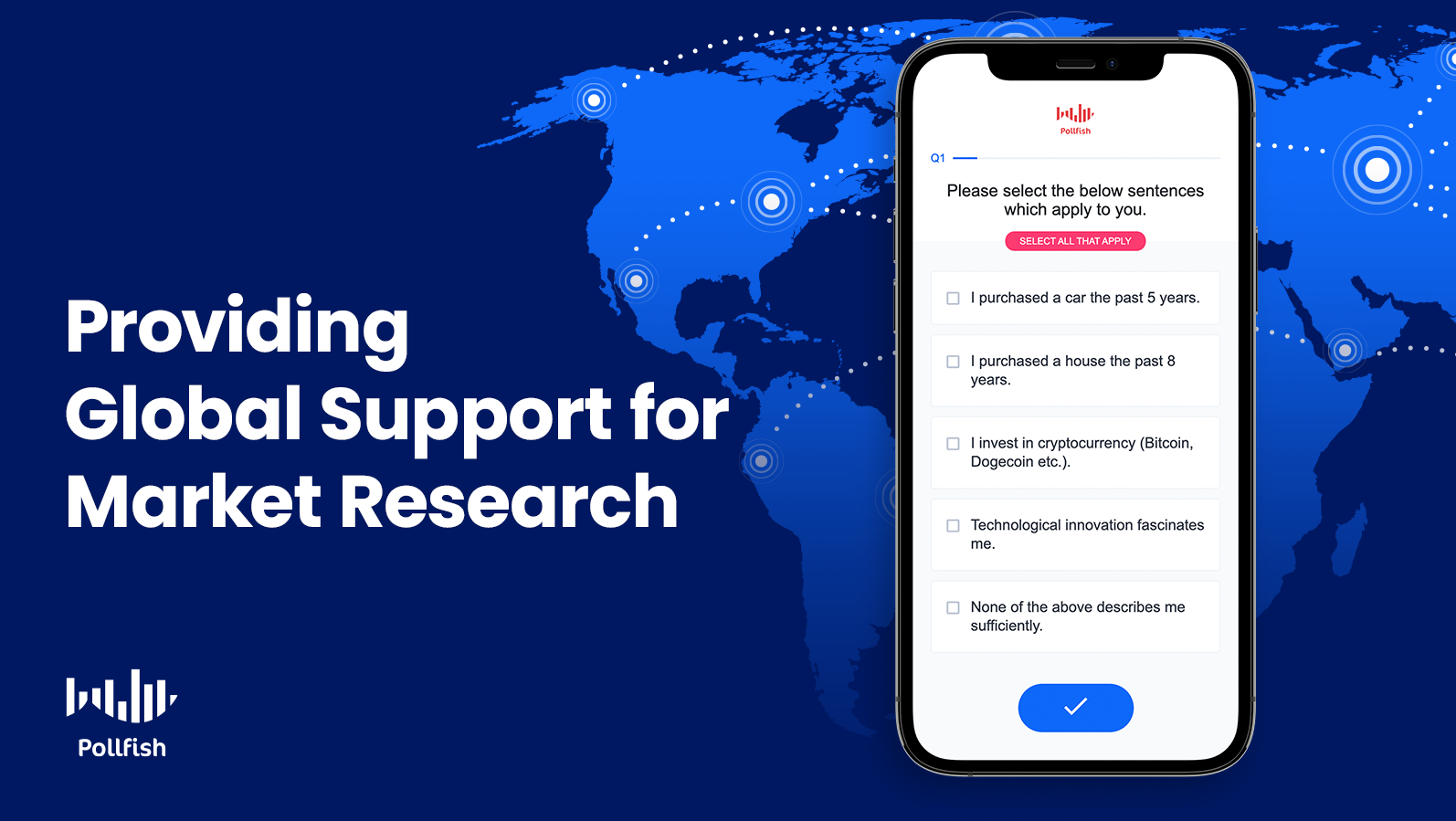
Market research is crucial for brands that have a global footprint, as well as those seeking to venture into the international stage. Pollfish empowers businesses with global support for all of their global market research needs.
This kind of research is a must for tapping into the minds of a global target market, along with building customer loyalty across the world. 95% of global customers consider customer service as essential in their business choice and loyalty.
It is virtually impossible to create a strong customer service and experience for global customers without understanding their habits, opinions and needs. Thus, conducting market research is essential.
While there are plenty of syndicated research firms and market research platforms available, they do not all deliver robust global support for international market research.
This article lays out how Pollfish is the ideal platform for conducting market research across nations, along with a use case from an app client that shows the prowess of Pollfish global support.
Global Support Capabilities for Market Research
A potent market research campaign should involve using a tool that makes it easy to access global markets and one that can operate at speed. Ideally, it should take the same amount of time to run a global market research campaign, as it would a domestic one.
Survey research is a practical form of conducting global market research, but not every survey platform is built the same. As such, not all platforms provide the same kind of quality for conducting surveys locally, let alone abroad.
Pollfish provides a unique edge to businesses who seek to branch out into the global arena, as well as to companies that have an established global presence. There are several ways that the Pollfish online survey platform provides market researchers with top-notch global support, the kind that enables them to quickly gain customer insights from a multitude of countries.
First off, Pollfish offers customer support on a 24-hour basis, so researchers in practically all parts of the globe can get support at any time of the day. Thus, they’ll never have to change their busy schedules to accommodate their market research tool. Instead, the platform is accommodated to their liking and needs. Any misgiving, doubt or difficulty they may experience is no problem for our team of market research experts working round the clock to ensure an effective global survey study.
Next, the Pollfish platform does not charge businesses extra for running surveys outside of their home countries. As such, market researchers can freely conduct global market research, reaching any country they wish, without incurring additional charges. They have access to a wide net of global customers, all under one platform and without being monetarily constrained.
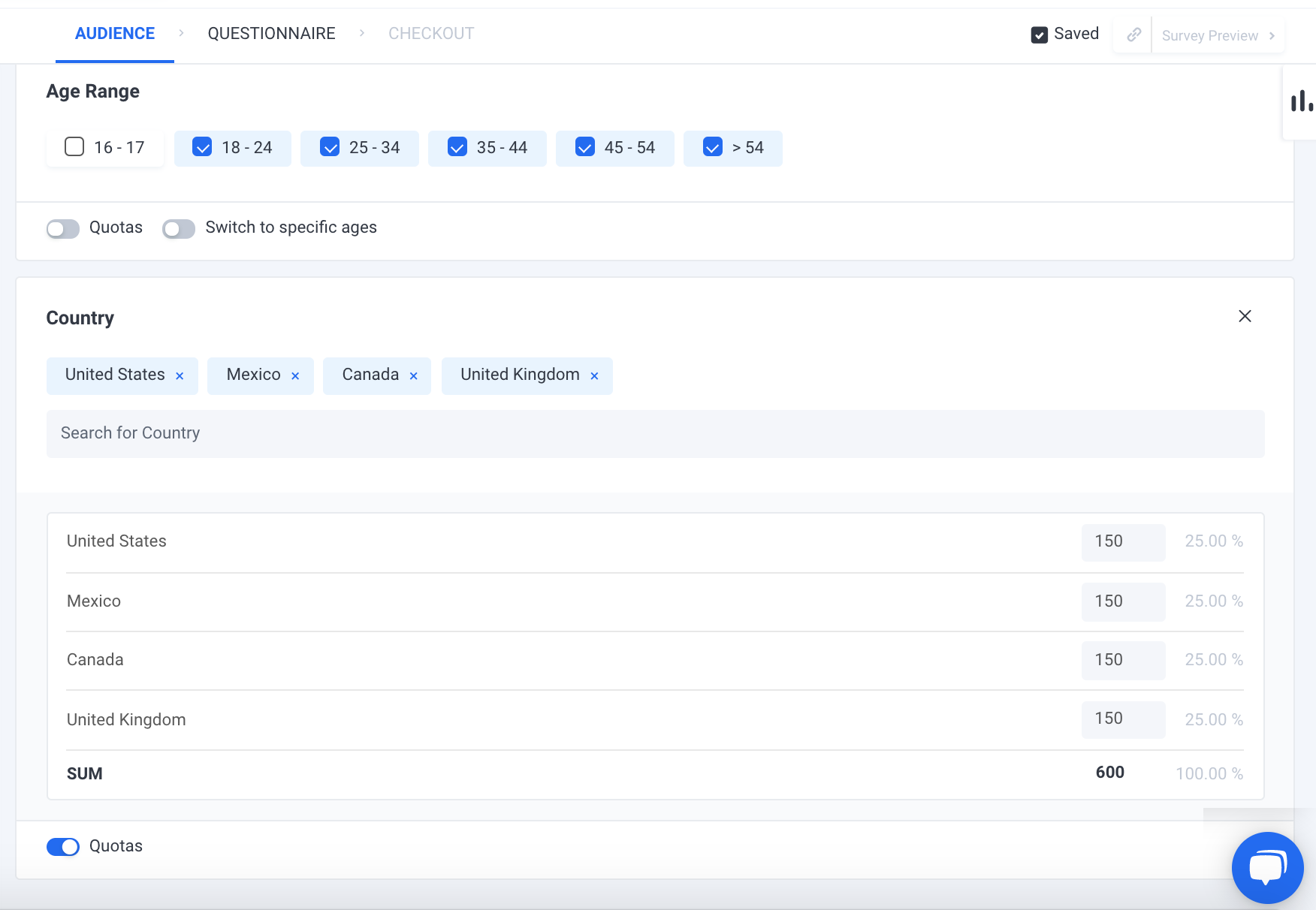
Finally, the Pollfish market research platform itself is equipped with various features that allow researchers to carry out their global research needs smoothly and quickly. This is largely because the platform is powered by some of the most advanced forms of technology, some of which eliminate the need to use other primary research tools and conduct secondary research.
The Prowess of the Pollfish Online Survey Platform for Global Research
In reference to the previous section, aside from the 24-hour support and no additional charges for global surveys, the Pollfish online survey platform offers many high-quality features for conducting global market research.
The following lists all the capabilities that Pollfish offers to ensure a strong and seamless global survey research campaign:
- Survey deployment to 160 countries
- Translations feature
- Multiple audiences feature
- Allows researchers to filter audiences by country, in order to see results on a per-country basis for comparisons.
- Survey deployment and iteration is executed at speed
- Researchers can survey up to 10,000 respondents per survey
- Reaching customers internationally does not require a longer survey completion time.
- It takes the same amount of time to deploy, illiterate and retrieve global responses.
- Targeting virtually all demographic groups
Use Case with Pollfish App Client
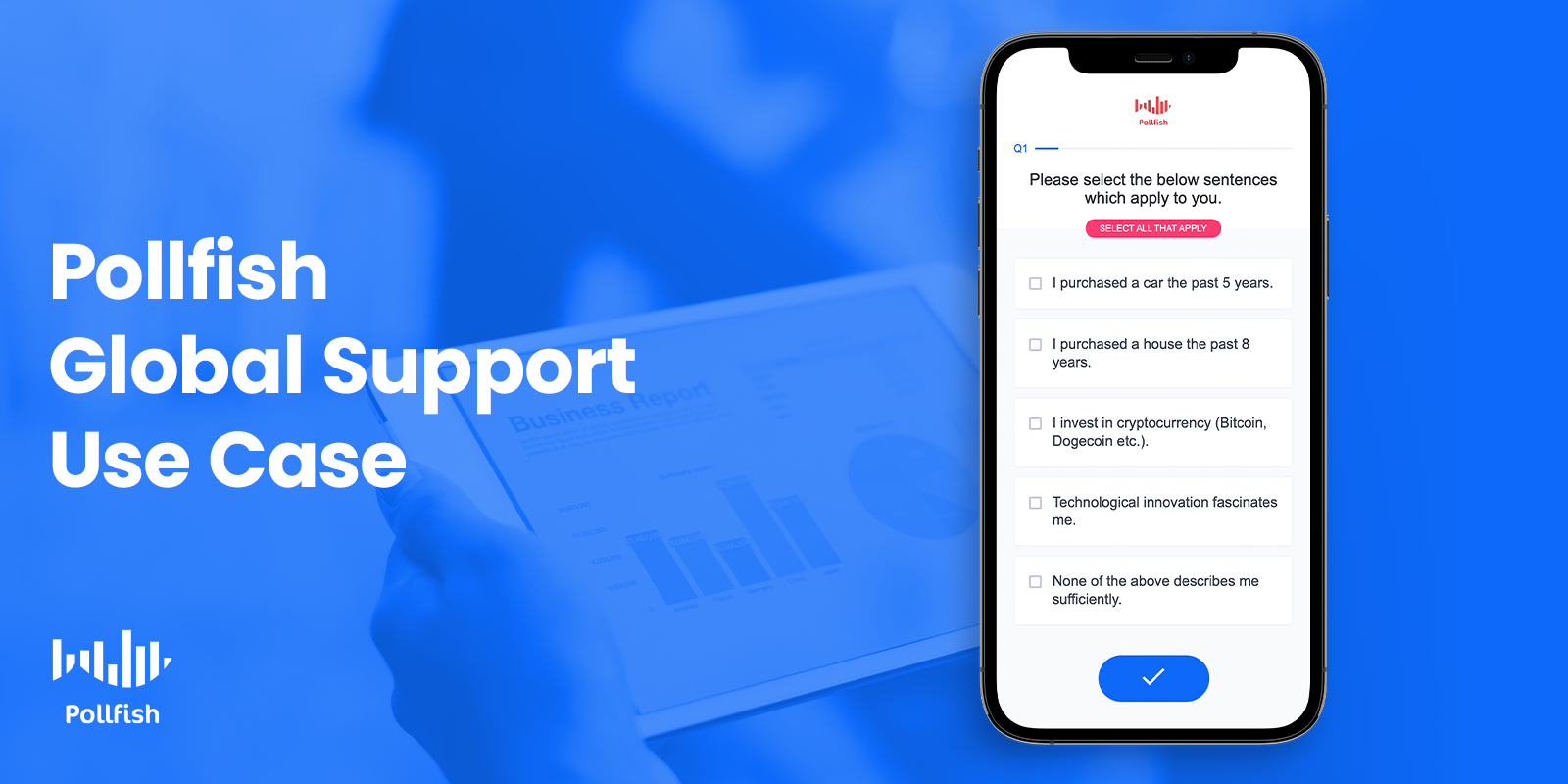
A Pollfish client used the Pollfish survey platform for a global expansion campaign. Lingokids, a learning app for young children, sought to expand the presence of its app in order to achieve international brand awareness.
Lingokids faced several challenges in its pursuit. First off, it still needed to crack the challenge of developing local brand awareness, making that of the global variety a much more difficult feat.
The app client also set out to generate stories for press releases that speak to its target market.
With traditional market research models, the client would have endured limitations and high costs. But with Pollfish, Lingokids received access to a reasonably-priced self-service platform market research that operates on RDE (random device engagement sampling).
RDE is a kind of sampling that engages users in their natural digital habitats, without pre-recruiting them. Rather, their participation is completely voluntary and anonymous. Thus, the respondents are not pressured to answer questions in any particular way, which stamps out certain survey biases and fraud.
The platform uses artificial intelligence and machine learning to perform ongoing quality checks as the surveys are running. This way, all of the resulting customer data that researchers receive is of the highest quality. These checks filter respondents through various kinds of quality criteria and disqualify participants who do not meet these standards.
For example, surveys with gibberish answers and flatlining answers (same multiple-choice answers consecutively) are disqualified, along with respondents that mask their geographical location or use a VPN. This method discards poor data, removing biases, errors and useless information — without the researchers having to lift a finger.
Based in Spain, Lingokids started launching Pollfish surveys in 2019 Sain to generate data and stories for press releases. But Lingokids’ success is not limited to Spain. The app client surveyed customers in other geos, such as the US, Mexico, and other countries.
“I’ve seen amazing results. If I put together all the press releases based on Pollfish data, not only in Spain, but in the US, Mexico, and other countries, I would say we’ve gotten over a hundred stories in tier 1, 2, and 3 media. That’s pretty good for a start-up,” said Sara Mateos-Aparicio, Communications Manager at Lingokids.
As a Spanish company, understanding the US market has posed several challenges. But
survey data from Pollfish paid off, as Lingokids used their survey data for different media campaigns in California and New York. The survey data helped them measure impacts pre-and post-campaign.
Those surveys were completed in about three to four days, with Lingokids also having received 800 survey responses in 24 hours.
Lingokids was able to not only measure and grow its brand awareness, but understand how to grow globally by analyzing the media types that work best to reach its target market in different countries.
Survey data also helped Lingokids learn about its competition along with gathering subtle insights into the culture of the US market. For example, Lingokids learned that children’s safety with learning apps concerned US parents more than parents in many other countries. This granted Lingokids the insights it needed to better launch US campaigns, having centered them on safety.
In summary, by running international surveys on the Pollfish online survey platform, Lingokids obtained over 100 stories in tier 1, 2, and 3 media, measured brand awareness in pre-and post-media campaigns, netted 800 survey responses in 24 hours, unearthed data on the competition in other countries and gained actionable insights into other cultures.
“You can make assumptions about your market, but they’re just assumptions,” said Sara Mateos-Aparicio, Communications Manager at Lingokids. “With Pollfish, you can confirm those
assumptions and they become data.”
Global Support with a Strong Online Survey Tool
While plenty of online market research platforms offer a best-in-class solution, not all such platforms offer global support and capabilities as does the Pollfish platform. Businesses who are serious about studying their target market in other countries must use a robust online survey platform.
Businesses should therefore invest in a platform that allows them to study their global customers at scale and at speed, without worrying about incurring higher costs or running into technical issues.
A self-service survey platform, Pollfish gives businesses quick access to various global markets and offers 24-hour support, should researchers encounter any difficulties or concerns. It helps hundreds of clients run global market research on a daily basis.
If you would like to learn more about how Lingokids leveraged the Pollfish platform, read our use case.
How to Build a Strong Survey Campaign for Market Research
How to Build a Strong Survey Campaign for Market Research
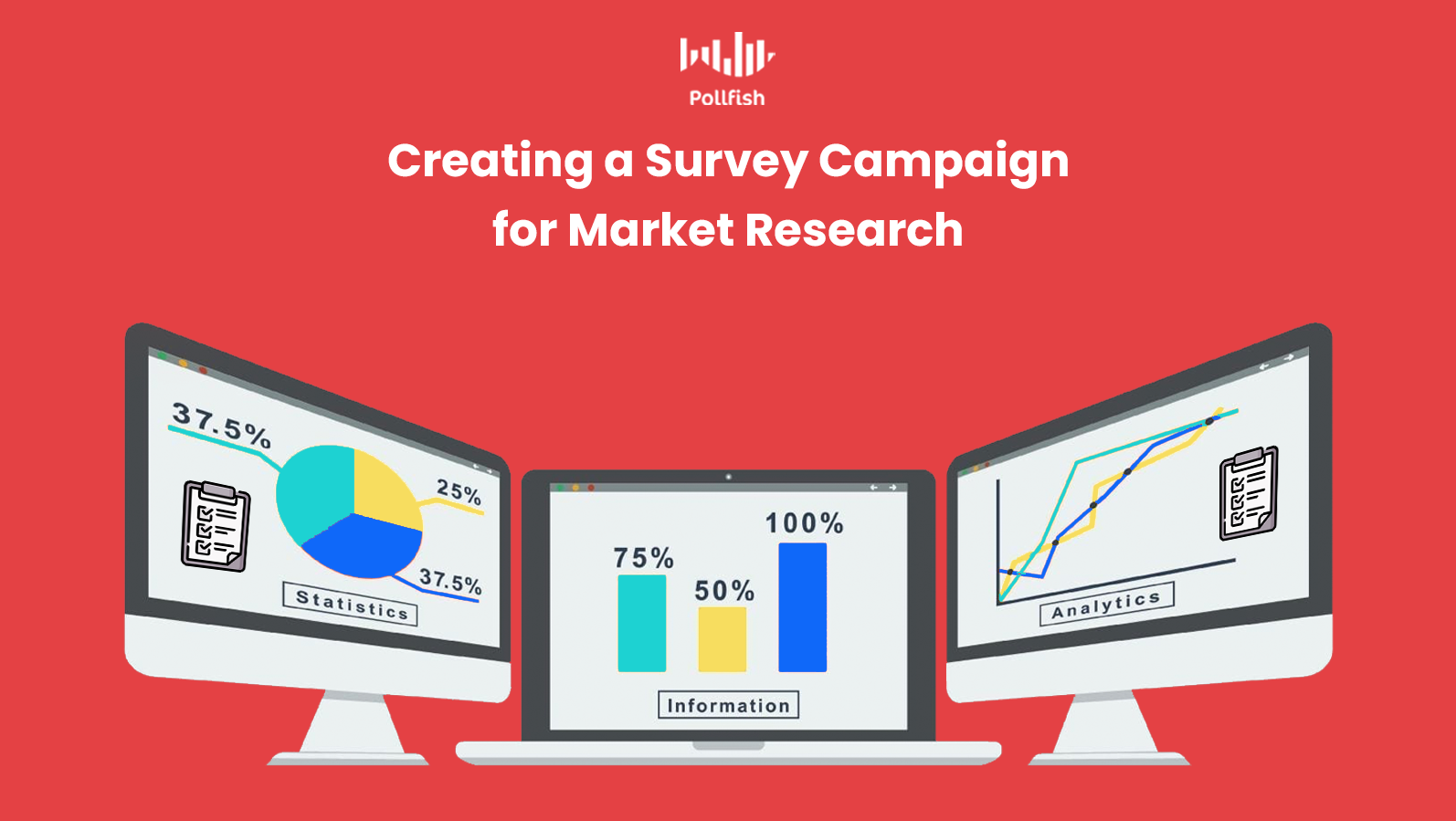 A strong survey campaign is invaluable for market research. This is because survey studies provide the most potent means of gathering your own unique research — primary research, that is.
A strong survey campaign is invaluable for market research. This is because survey studies provide the most potent means of gathering your own unique research — primary research, that is.
A survey campaign is part of a far larger endeavor, as it is just one methodology in a research campaign. Thus, it requires more than merely being planned out; researchers must decide on one of the types of research to conduct before settling on a survey.
There’s also more when it comes to producing a strong survey campaign. This article explains this in full detail, so that businesses and market researchers can create surveys that reap the most insights.
Defining a Survey Campaign
A survey campaign is a series of efforts used to gain firsthand data from a target market in market research, or a target population in general research.
This kind of campaign is a primary research method in which researchers attempt to find a solution to a problem. For example, it can focus on the problem they would come upon in descriptive research.
But there’s much more to survey campaigns. Although they can be used to resolve problems discovered in a type of research, such as exploratory, causal, etc., they can be used for a wealth of other purposes.
When it comes to business, a survey campaign can determine if a new strategy will be beneficial, detrimental or affect little to no changes. What even more important is that such a campaign allows businesses to understand the lifeblood of their business: their customers.
What a Survey Campaign Helps Reveal for Your Business
Dovetailing off of the previous section, there are many things a survey campaign can help a business achieve. Some of these go beyond market research itself.

Here are some of the other purposes a survey campaign helps serve:
- Understanding the makeup of your target market
- Via the target market survey
- Market segmentation for further segmenting
- Testing a creative strategy for a number of macro applications such as
- Advertising
- Branding
- PR
- General marketing
- Obtaining customer feedback and getting a deep read of your target market
- Via a customer satisfaction survey
- Includes the NPS, CSAT, CES, visual rating survey & more
- Discovering the CLV (customer lifetime value)
- Via a customer satisfaction survey
- Excelling in product endeavors
- Testing product satisfaction
- Innovating products with new features and upgrades
- Understanding how your product compares with competitors’
- Avoiding negative publicity
- Regular checks on the opinions of your brand
- Finding customer aversions to avoid in your messaging and brand’s image
- Obtaining employee feedback
- Running a pulse survey
- Via the employee satisfaction survey
- Improving your CX
- Via a customer experience survey
- Using a survey for content marketing strategy
- Driving Lead generation
- Includes B2B endeavors
- Helps you learn more about the specific needs and desires of your target market, or B2B clients such as partners, vendors and other businesses.
- Acclimating with your niche
- Allows brands to keep up with market and niche trends
- Makes it easier to change with the times
- Completing a market analysis
- Being able to compare your brand with others
- Getting a feel of the thoughts and attitudes in your overall space
Proving the Value of a Survey Campaign
While many brands turn to market research, they do not always carry it out successfully. With primary research specifically, it is more difficult to reap accurate, bias-free insights, as it involves far more than just an analysis, but the labor of conducting the research yourself.
Additionally, a business may encounter the issue of biases, a lack of participants and even responses that are hard to draw conclusions from.
A survey campaign provides the antidote to all of these problems — when conducted correctly, that is.
A survey campaign is useful for reasons beyond the 10 in the aforementioned list. Here are a few ways this kind of campaign is a must for businesses:
Since surveys help measure the CX (customer experience), they inform businesses on a variety of touchpoints that influence their CX and how they do so. This is important, as 86% of buyers are willing to pay more for a good CX. Thus, a business can improve its customer experience, which will therefore increase sales.
76% of customers expect businesses to understand their needs. A properly designed survey campaign will do exactly this. This is because you can create a number of different, although related surveys under one campaign. By creating diverse surveys, you can study a more diverse set of segments in your target market. This kind of research will help you understand and adapt to their needs.
When it comes to branding and customer loyalty, businesses can stand to run a survey campaign for a variety of reasons. First off, 86% of consumers believe that authenticity is important when they decide on the brands they choose to support.
Surveys can also help in brand recognition; simply deciding on a correct signature color can spur brand recognition as high as 80%. Creating a survey campaign with visually-oriented surveys can achieve this.
Then comes the sensitive issue of news and culture, particularly social and political issues. 64% of consumers from across the globe said that they would either boycott or buy from a company simply for its political or social stance. A survey campaign allows you to quiz your target market on its thoughts surrounding current affairs so that you take the correct position or none at all.
How to Build a Survey Campaign
The following explains how to set up a survey campaign, ensuring you use the correct surveys, frequency and other functions within your campaign.
- Find what it is you need to study; consider the things that matter to your business and have little to no research, such as what you would use in exploratory and explanatory studies.
- Or, if you have already conducted exploratory or explanatory research, consider other related factors or issues that you’d like to study.
- Once you find a topic of study, which can be any business phenomenon, for example, a decrease in sales of a particular product, tie it to a larger purpose or campaign.
- For example, perhaps it fits into branding more, or perhaps it is an advertising issue.
- When you’ve affixed your campaign with a macro-application (ex: advertising), decide whether you’ll need to run one or several surveys.
- Consider conducting causal research on the matter, as this will find cause and effect relationships and since survey launches are one of the last steps of the entire research process.
- If you perform this research and discover cause and effect relationships, you may need to rework your intentions or original questions.
- Come up with several questions. An ideal starting point is to sift through the 6 main types of survey questions and to deliberate which will be of most use.
- Using the question types as question templates, form your questions.
- When you’ve come up with 10-15 questions, consider cutting them and organizing them into two or more surveys. (Shorter surveys have greater response rates).
- As you organize your questions, create the appropriate theme for each survey.
- Create a callout that briefly explains what the survey is for.
- Customers are fond of transparency.
- Here you can mention that the survey is to improve their own CX, or that their opinion matters.
- Use a strong online survey tool to create, launch and run your survey to the correct target market.
- Perform a survey data analysis and jot down key findings.

- Use your findings to draw a conclusion about a hypothesis, or continue doing further research, such as correlational, causal or even experimental.
- Your original results will bring key findings that answer your work’s key questions, answer a hypothesis or prompt further research.
- This may require further survey research.
Consolidating Your Research
A research project often manifests as a long and winding process, rife with several sub-campaigns and tasks. A survey campaign can help tame this process, easing the way to finding key results.
This is because surveys provide agility and speed to insight — when conducted correctly. It is virtually impossible to find hundreds or even thousands of respondents that properly fit your target population, let alone convince them to take a survey.
That’s where an online survey tool offers a multitude of value, as it can carry out these tasks and more, with little to no effort from you. A strong online survey tool is thus a necessity for your survey campaign needs.
Diving Into the Pulse Survey to Meet Business Demands
Diving Into the Pulse Survey to Meet Business Demands

Running a pulse survey is key to properly running a business — and running a business is not always a smooth operation. There is a wide breadth of considerations to carefully examine, yet even with continual check-ups, they are still susceptible to going awry.
When you measure the pulse of your business, the premise that the pulse survey hinges on, you are able to keep track of your business and how others engage with it — be they your customers, your partners and your employees.
This article delineates the pulse survey in-depth, so that you can build effective survey studies for your market research needs and be in tune with the pulse of your business.
Defining the Pulse Survey
The pulse survey gauges the pulse of your business, as its moniker indicates. “Pulse” refers to the “motions” the key individuals to your company go through in regards to your business. As such, this survey type must be administered frequently.
Like a biological pulse, the rhythmical throbbing of that which keeps you alive, i.e., blood — a business’s pulse involves understanding the lifeblood of its business. This includes customers’ opinions, employee engagement and sentiment and the thoughts of your vendors and partners. The latter is especially true for a B2B business.
As such, when those in the business world discuss “keeping a pulse” on their company, they are alluding to collecting the feedback surrounding this pulse.
Pulse surveys often refer to employee pulse surveys, which are a kind of employee feedback survey, however, they can collect the pulse from a variety of respondents and serve various purposes. These include:
- Evaluating customer satisfaction
- Measuring employee satisfaction
- Finding the opinions, needs and sentiments of partners, business clients and vendors via B2B surveys
- Understanding your content consumers via content marketing strategy
- Getting insights into the operations of your business
The Key Characteristics of a Pulse Survey
What specifically makes up a pulse survey?
Pulse surveys contain more specifics than merely the key trait of gathering feedback to understand the inner workings of your company. Instead, they include key aspects you need to adhere to when deliberating how you’ll use this survey type and how to create one.
- Marked by frequent check-ins on the same audience.
- This can be weekly, monthly, bi-annually, quarterly or set in a custom frequency.
- They measure the impacts of small and large occurrences.
- The surveys tend to be 3-6 questions in length.
- The surveys are concentrated on either a campaign, topic, experience, etc.
- They’re used to track trends and hyper-segment your respondents (employees, customers, etc.) similar to market segmentation.
- These surveys are used to study changes among opinions, behaviors, attitudes and more within a particular group.
- They can be used to compare shifts in opinions among certain segments with consistency in that of others.
The Importance of Using a Pulse Survey
Incorporating a pulse survey is key to ensuring various successes for your business. There are a number of ways in which the pulse survey benefits your business.
First off, it doesn’t merely tell, but it proves to your respondents that you value their insights. While not many people enjoy taking surveys, a short survey that explains in the intro or call-out that it is being conducted to improve the service/experience for customers lets them know that you pay attention to their needs.
This is beneficial when it comes to vendors and partners, as it gives them the reassurance that they are not merely contractually bound with your business, but that their input matters and that they have a say in the business relationship.
The same notion applies to employees, the group chiefly used in pulse surveys. Workplace stress is common; in fact 40% of workers reported that their work was extremely stressful. Thus, a pulse survey is necessary to curb workplace stress. It is also crucial to keep employees engaged and satisfied with their work.
After all, a happy workplace won’t incite them to leave the job, whereas a toxic one inevitably will.
As such, relying on a pulse survey grants you the insights you need to keep issues at bay and cater to the needs of your business.
The Advantages and Disadvantages of a Pulse Survey
A pulse survey offers several advantages to a business. If the prior section on the importance of using a pulse survey wasn’t reason enough to start regularly implementing it, the following enumerates even more benefits that this survey provides. Like any business tool, however, there are some downsides to a pulse survey as well, as the following includes.
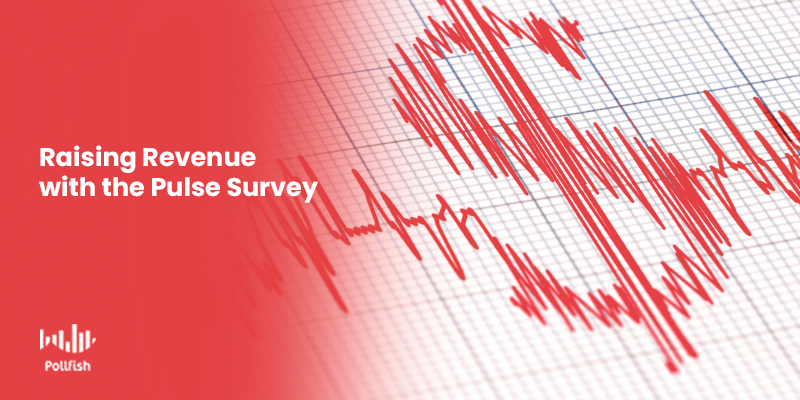
A pulse survey campaign can help raise revenue by improving customer/partner relationships.
The Advantages
- It is deployed periodically, giving you continuous key insights and updates on your target sampling pool.
- It identifies current (thus extremely relevant) insights on a wide array of issues and occurrences.
- The insights allow you to make much-needed upgrades, corrections and changes on a regular basis.
- Because it is employed periodically, you can identify trends and the ways in which your target sampling pool changes.
- It helps you understand the impact of events, whether they are large or minor.
- It shows you whether new employee policies, updated products or new vendor terms have had positive or negative effects.
- It is useful for assessing reactions to recent (or even ongoing) changes.
- It allows you to monitor virtually any activity or sentiment.
- These surveys tend to be short and thus are easy to create.
- Checking on the pulse allows you to zero in on current needs and objectives with a targeted set of questions.
The Disadvantages
- Requiring constant updates and feedback can be off-putting for customers, employees, vendors and all else.
- When no major event, change or attitude springs from the previous round of pulse surveys, it can be difficult to create new pulse survey targets without coming off as repetitive.
- These are not as anonymous or random as other business surveys, as such, some respondents will be reluctant to take them or refuse entirely.
- Less anonymity incurs less honest answers, giving way to survey bias.
How to Conduct a Pulse Survey
Creating a pulse survey requires taking several key measures to ensure you carry it out properly and gain the key data that captures your pulse. Here is how to create a pulse survey for your various needs.
- Start from scratch by defining the purpose of your pulse survey campaign.
- First, lay out the high-level considerations, such as who the targets of the survey are and which area of business you would like to survey.
- Then, find something specific and current that you need to check up on.
- Decide on the most apt length of your survey.
- This should be an approximation since you haven’t created your questions yet.
- Create a welcoming call-out and/or intro to your survey so that the respondents will be more inclined to take it.
- Include call-outs such as: “Your feedback means so much to us” and “Help us help serve you.”
- For employee pulse: “Let’s make work a better place,” and “Complete this survey so we can improve your work and responsibilities.”
- Create your questionnaire, consisting of 3-6 questions and no more than 10 for longer surveys.
- Make sure the questions are relevant to the topic/issue you are checking in about.
- Consider your answers; some may prompt follow-up questions while others won’t be relevant to all respondents based on their answers. Thus, apply advanced skip logic.
- Determine a suitable survey cadence.
- Taking the following into consideration: how often the aspects you’re surveying are subject to change.
- How soon you’re going to make changes and if those changes warrant immediate pulse surveys.
- Put together a list of positive and negative responses in your survey analysis.
- Ideate how to address the negative attitudes, i.e., how to allay them and what to change in your business.
- Use advanced people analytics to your pulse data for market segmentation purposes, as well as a deeper read of the pulse.
- Share the results.
- Review the results with the appropriate team. Ex: partnerships, marketing, HR, the product team, etc.
- If you run an employee pulse survey, share the findings with the entire team for the sake of transparency.
- Take action.
- After reviewing the results, take any necessary action to improve employee, customer and partner relations and satisfaction.
- Make necessary changes to the campaign itself, such as to the cadence, etc.
Pulse Survey Question Tips and Examples
Create questions that are broad (at least the early ones) so that they are pertinent to all the targeted respondents. The idea is to avoid survey bias along with question skipping.
Make sure to include at least one open-ended and one closed-ended question. This is especially useful if a multiple-choice question warrants an explanation, one that cannot always be answered via a follow-up multiple-choice question, but rather one with an open field.
This gives their original responses much more depth and a qualitative component to the survey.
Make sure your questions are specific and use skip logic if need be. Your questions should yield measurable data that creates actionable insights.
Here are a few pulse question examples:
Pulse Survey Question Examples
- Do you feel that the company has done a good job of informing employees about [initiative]? [Yes or no]
- If no, use skip logic to route them to an open-question for an explanation.
- Target audience: Employees
- On a scale of 1-7, how strongly do you agree with the following?: We have effectively managed the recent change in our organization.
- Uses a Likert scale
- Target audience: Employees
- What do you think of our new product feature?
- Use nominal answers (varied and not scaled)
- Target audience: Customers
- How can we better make your holiday shopping experience?
- Use nominal answers (varied and not scaled)
- Target audience: Customers
- How comfortable are you in supplying us [various goods, needs, etc]?
- Use a Likert scale and skip logic to an open-question for an explanation of a low rating.
- Target audience: Vendors and partners
- What are some of the changes you would like to see to ensure a mutually beneficial partnership?
- Use an open-ended question.
- Target audience: Vendors and partners
Continually Improving Your Business
Regardless if you are a B2C or B2B company, in order to sustain a successful business, you need to monitor the pulse of various issues in your business. Whether it is ensuring a lengthy partnership — one with renewal, achieving a higher CLV (customer lifetime value) among customers or maintaining employee satisfaction, you need to implement a pulse survey campaign.
Such a campaign will enable you to keep a constant check-in on the aspects of your business that matter the most, along with those in need of alterations the most. Either way, deploying a periodic pulse survey to various targets will help you understand the key players of your business.
This will allow you to serve them better and forge business relationships with longevity.
A successful pulse survey relies on a robust online survey platform. This tool should be able to facilitate a vast amount of survey types and styles and deploy them to the correct audience with ease and little to no effort from the researcher.
If you have such a tool in hand, you are setting up your business for various successes.
Conducting Global Market Research with a Dynamic Market Research Platform
Conducting Global Market Research with a Dynamic Market Research Platform
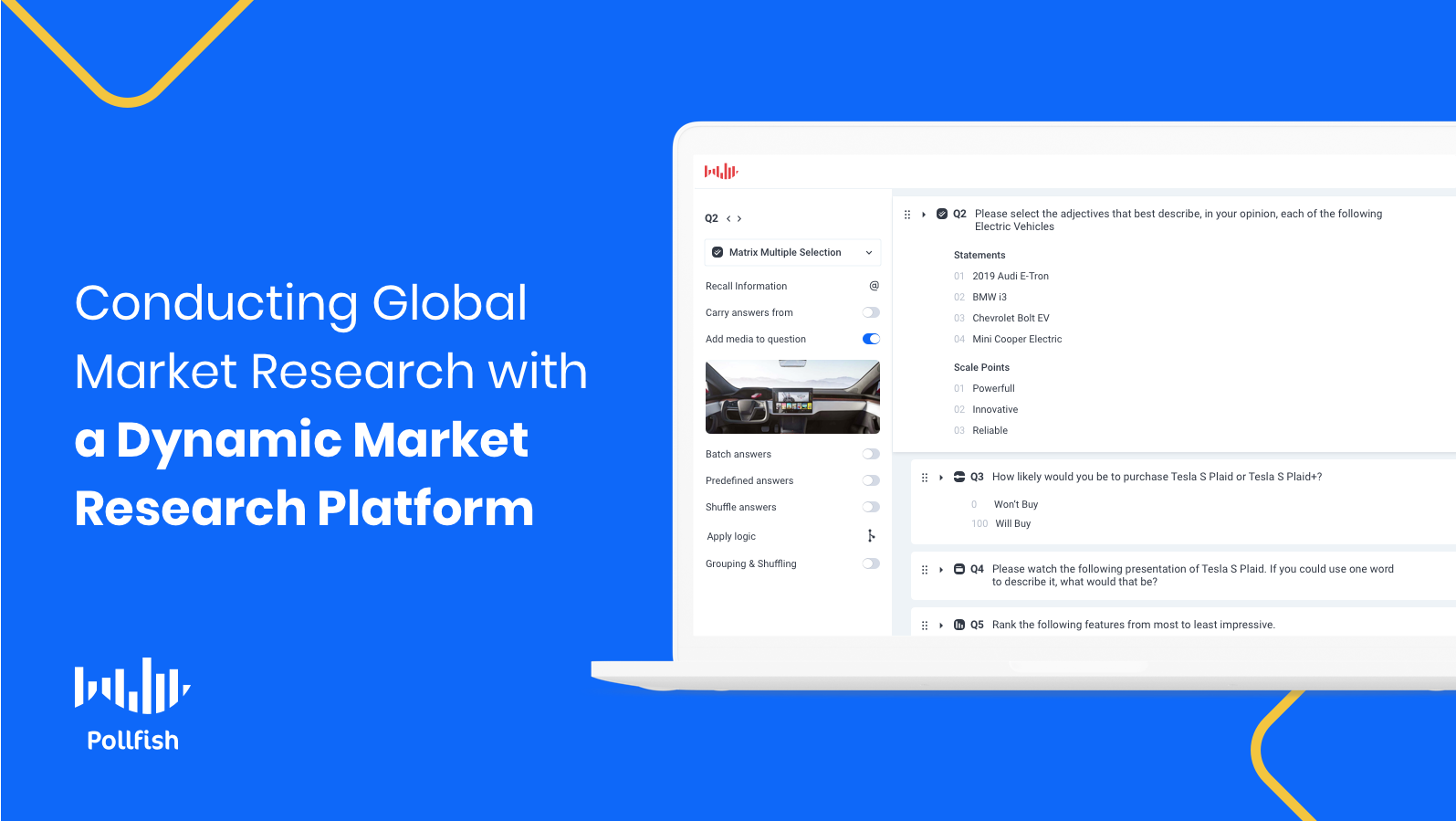
Businesses that seek to offer products and services to international customers would be remiss not to conduct global market research. This form of research prepares both current businesses participating in a global market, along with prospective ones.
Understanding customers from across the world is equally highly regarded internationally, as it is in the US. 66% of global customers expect companies to understand their unique needs and expectations. As such, providing the correct experiences and fulfilling the needs of customers is no longer a secondary requirement for global consumers.
Performing market research should therefore not be limited to domestic studies, whether it is for an international e-commerce business or a content provider who seeks global research.
This article expounds on global market research, its importance, key components, challenges and how to conduct it, along with a use case from a real Pollfish client.
Understanding Global Market Research
Global market research stems from the same idea as traditional market research — the process of gathering information about target markets and customers in a specific industry.
Global market research refers to the organized effort of systematically collecting, recording, designing, analyzing and interpreting information pertinent to a target market on a global scale. As such, this kind of market research studies individuals outside of local and national markets, examining those in the international space instead.
There are various market research techniques that market researchers can apply to their global market research campaigns. Existing and emerging technologies facilitate these efforts, breaking down what would have been obstacles.
Global market research is not the complete equivalent of traditional or domestic market research. While these two forms of research are parallel in certain regards, they differ in their approach and focus on different core subject matters.
Market research on a global scale is applicable to all business concepts, from the viability of new products to studying and increasing customer lifetime value (CLV). Therefore, conducting market research across the globe can help businesses improve in various ways and meet a wide variety of KPIs and objectives.
The Importance of Global Market Research
This kind of research is invaluable on various fronts — for businesses and general research purposes alike.
Firstly, the constant advancement of technology has opened many international business opportunities for companies to expand their business by venturing abroad. This is especially the case for SaaS companies and businesses that provide services that don’t require shipping materials to foreign countries. Thus, it is far more efficient to offer global services.
This means that businesses have target markets that far exceed those within their home country. To compete with any business in any industry, businesses must satisfy their customers and these concepts lay the foundation of the importance of global market research, because, to please customers, businesses must understand them at granular levels.
Market research provides a means of doing so, with various sources and methods to extract data on global customers.
Secondly, marketing strategies do not pan out in the same way across localities and different segments of a target market. As such, they will certainly not be received in the same way across different countries and continents.
Due to different cultural norms, languages and connotations, a company’s messaging, communications and marketing campaigns will therefore not have the same effect as they intend in different geographical markets. Global market research helps reconcile these differences across countries, by specifically focusing on cultural and geographical differences.
Additionally, information that contains the exact responses from a business’s global customers arms it with the knowledge and insights necessary for various business operations. It provides valuable information on executing changes or launches to product development, design, delivery, packaging and quality.
It also allows marketers to establish unique advertising campaigns, ones that are either made solely for a particular international market, or those that tweak existing campaigns to fit the cultural norms and sensitivities of other countries.
Moreover, conducting this research helps businesses properly set their prices when selling to customers abroad. This way, their pricing is reasonable across countries. For example, a piece of furniture may retail for a completely different price in the US than it would in France.
Furthermore, the global digital population is on the rise, with 4.66 billion active worldwide internet users. This figure represents 59.5% of the global population. A vast majority of these users, 92%, access the internet via mobile devices.
It would be negligent for businesses not to study this colossal population to improve all of their marketing and general business goals. They would simply need to use the correct online market research platform to examine this inflating population.
The Components of Global Market Research
Global market research has its own set of key components, some of which largely distinguish it from traditional and domestic market research. These components allow researchers to focus their survey research exclusively on the behaviors, sentiments, opinions and needs of customers abroad.
By paying attention to these components, businesses can gain insights that improve any globally-targeted marketing campaign and even forge brand loyalty.
The following lists several major components of global market research:
- The focus on a specific geography: Market research allows businesses to zero in on a specific country or continent.
- Reaching customers that appear to be unreachable: This involves using market research techniques to reach international customers directly, that is, through primary research tools, such as a focus group or an online survey platform.
- Not all market research methods and tools offer the same global reach.
- An analysis of cultural differences: This covers examining all possible cultural differences, from the role of women versus men in shopping, to religious holidays, to business closings, etc.
- Essentially, this allows brands to adjust their marketing and create messaging that can better relate to customers in different countries.
- An analysis of economic differences: This is critical to understand when setting up a global pricing strategy. This is because all countries have different economic climates; some may be undergoing a recession, some may incur strong unemployment rates, while others may be experiencing an economic boom — at least in a particular market.
- Tapping Into global markets via their native language: Not all members of a global target market speak English, which means that to study them, researchers will need to reach them in their native language.
- Ethnic considerations and national customs: Similar to cultural differences, studying specific national and ethnic concerns is important, as it helps businesses avoid marketing campaigns that can offend global customers’ sensibilities.
- Understanding typical Incomes: The income considered low or middle-class in one country may not be so in another. Global market research helps brands understand how typical incomes are classified across global regions.
- Additionally, it reveals common salaries and other income information across the demographic groups of a country.
- Product demand: Some countries will have demand for things that barely get an afterthought in other countries. This can be for a specific product or a product feature enhancement.
- By conducting global market research, businesses can understand the exact needs of their global target market and innovate accordingly.
- This way, they can create more viable products for international sale and satisfy their customers abroad.
The Challenges of Global Market Research
Global market research is beset with its own share of challenges that make it difficult to conduct, let alone complete. However, there are survey tools that make conducting this form of research practical and easy. But first, businesses need to acclimate themselves with the challenges that may come their way should they conduct global market research.
While some techniques and methods used in domestic market research may also be applied to their global counterparts, customer preferences are not easy to determine. As such, it is difficult to compare global markets due to the greater diversity in cultural, social, and economic differences, all of which affect consumption.
Then there is the challenge of conducting the research in the first place. Global market research is a far more ambitious project, therefore, it tends to require more hours on conducting various techniques, such as scouting for secondary research. These will differ among companies and research campaigns.
As far as methodology goes, global research also requires more time spent on execution. Researchers would need to contend with extracting the data, designing the study either across one country abroad or multiple countries, coordinating between different countries and piecing together the resulting data.

These are just some of the points of friction that businesses must grapple with before conducting their global studies.
Market researchers must also be somewhat knowledgeable of the local customs and environments of their respective targeted countries to carry out the research successfully, especially when conducting primary research. This will help researchers avoid making their subjects feel uncomfortable, therefore cutting back on survey attrition. This will also help researchers structure their primary research.
Then, there is the monetary challenge: large survey research projects are costly endeavors, some of which may incur hundreds of thousands a year. This is especially challenging for businesses that have just broken into the international market.
How to Conduct Global Market Research
Conducting global market research requires many of the prerequisites of domestic market research. A business will have to compile secondary and primary resources to perform an exhaustive study.
There are various secondary sources that businesses can incorporate into their global research.
Government agencies provide free access to statistics on their residents, a kind of hard data that is valuable for preliminary studies. These statistics are useful for learning about a foreign country’s demographics, state of its economy, and commerce status.
The International Trade Administration churns out economic reports, forecasts and infographics on various countries and industries. Their website can complement domestic market research, as it contains statistics on US national trade.
Researchers can also attend international trade shows, workshops, and seminars in their industry — some offer this virtually. For example, The Tradeshow Network Marketing Group lists all the major international tradeshows and their respective industries.
Each industry also has dedicated online publications that publish articles on emerging trends and news on the industry, including customer preferences, technology, products and services and other related information.
Finally, businesses need to conduct their global market research; this can be done in several ways. They can turn to survey panels, mail-in surveys, phone calls with existing customers and field research.
Online surveys are the most potent tools for global market research.
This is because an online survey platform, such as Pollfish, offers the best distribution method and allows businesses to study any segments of global customers, as it reaches 160 countries.
Using random device engagement (RDE), Pollfish targets digital users in their natural environments. Thus, respondent participation is randomized and voluntary, removing the risk of survey bias, as respondents are not pre-recruited and completely anonymous. Pollfish has the power to deploy surveys to a vast network of global customers, as it distributes surveys across the most visited websites and apps, to a sampling pool of 250 million people.
Additionally, Pollfish allows survey creation for 46 languages and also offers a Translate Survey feature. This way, businesses can seamlessly reach non-English speaking customers across the world.
Researchers can meet all of their quotas with the Pollfish online survey platform, with the option of adding quotas in the screener, along with multiple audiences per survey. This way, they can target various segments of their global target market. The platform also offers a survey completion time, so that researchers have a reasonable estimate of the time it takes to draw all the preset survey responses.
Global Market Research Use Case with a Pollfish Client
Kalsec, a food manufacturer that produces space and herb extracts, colors and food protection for the food and beverage industry, has used the Pollfish platform to run a global market research campaign.
Thus, the company deployed surveys in various global markets: those in the North American, European and Asian regions, specifically in Canada, the UK, France, China and Thailand. Given that to understand the needs of global customers, businesses must conduct studies on various global regions on a country-to-country basis.
This is exactly what Kalsec did, arming the business with critical insights they would need to pay extra for, had they used another online survey provider.
Specifically, Kalsec studied consumer behavior and purchase decision-making to get a sense of its global customers' purchasing behavior about its brand. The surveys that Kalsec ran centered on the snacking behaviors of residents in the five aforementioned countries.
The company sought insight on what drives customers from making their snack purchases and their Pollfish-powered global market research allowed them to compare customer behavior across various countries and better tailor their shopping campaigns.
Essentially, Pollfish technology broke down geographic and communication barriers across these global markets, granting speedy insights that the company wouldn’t obtain from secondary research alone.
Making Continuous Improvements in the Global Arena
Businesses that seek to offer their services to global customers ought to make use of global market research. The same goes for businesses with an established global presence, given that understanding customers is at the core of maintaining business success.
To conduct global market research, businesses need to use a robust online survey platform, such as Pollfish. A strong online survey tool will enable businesses to set granular demographic requirements for global customers, ask a wide style of questions (multiple-selection, single selection, ratings, etc), add advanced skip logic, add media files and use multiple audiences per survey.
Pollfish is built for global market research, as it offers 24-hour support, so that regardless of which time zone a client is in, they can easily reach the customer support team should they require assistance. Pollfish users do not have to pay more to gain access to global customers and send global surveys, a major advantage over the many other platforms.
A DIY survey platform, Pollfish allows businesses to make global market research an attainable goal.

